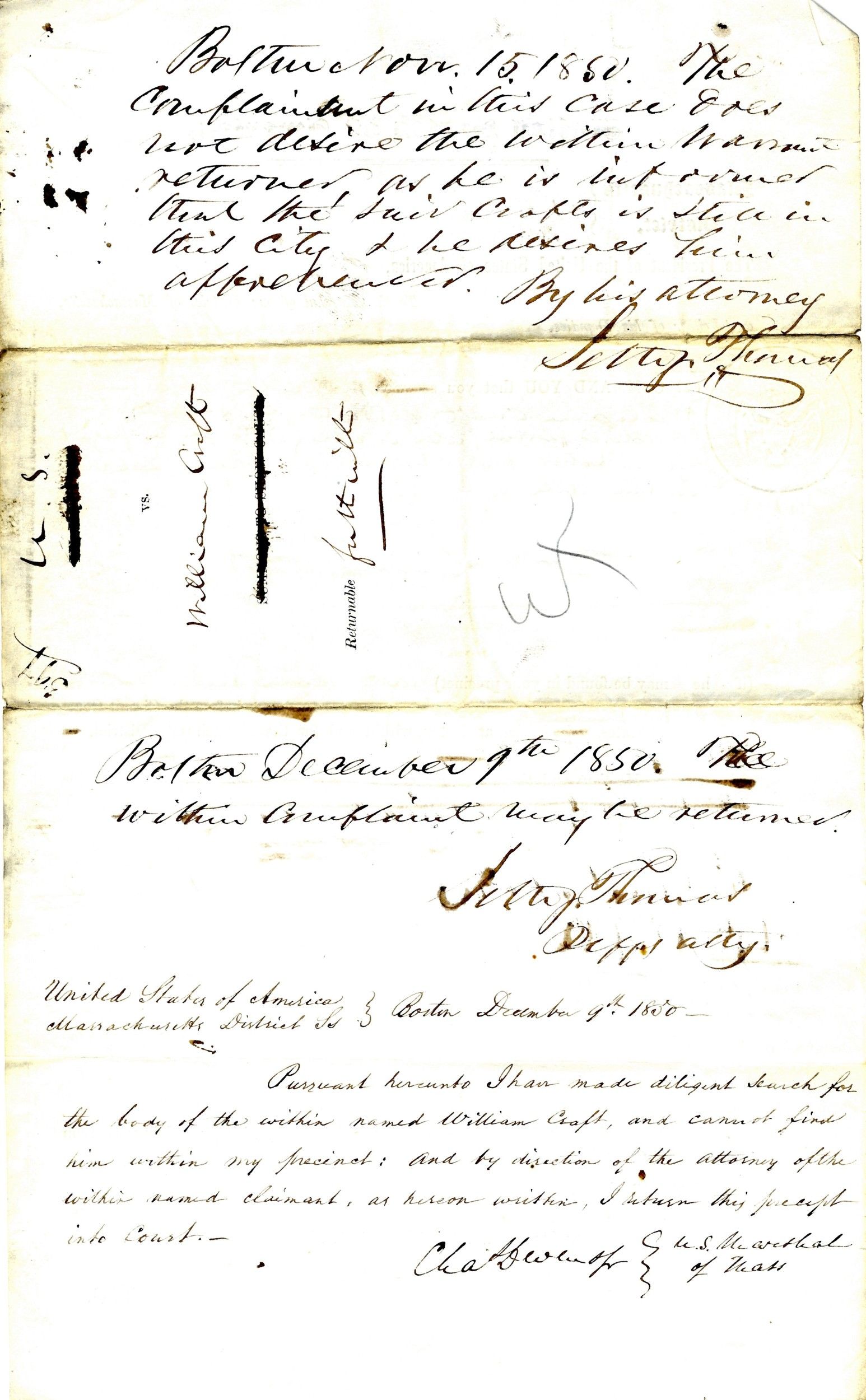Oh Freedom! Sought Under the Fugitive Slave Act
Making Connections
All documents and text associated with this activity are printed below, followed by a worksheet for student responses.Introduction
The issues of slavery and freedom are older than our nation. From the very beginning, the enslaved people of our country, with support of those against slavery and an organized resistance, entered the struggle for freedom. Theirs are individual stories of courage, danger, and defiance. William (1824-1900) and Ellen Craft (1826-1891) were enslaved people who escaped from their respective "masters" in Macon, Georgia, in December 1848.Examine the following historical documents to learn this true story. You will write a narrative of the story when you complete the activity.
Name:
Class:
Class:
Worksheet
Oh Freedom! Sought Under the Fugitive Slave Act
Making Connections
Examine the documents and text included in this activity. Fill in any blanks in the sequence with your thoughts and write your conclusion response in the space provided.William and Ellen Craft were enslaved in Macon, GA, but escaped from their respective owners in December 1848. Ellen, the daughter of an African-American woman and a White master, passed as White. She traveled disguised as a gentleman accompanied by a slave valet, William.
They made their way to Boston, MA, and the U.S. Census of 1850 shows them living in freedom at the home of Lewis Hayden.
After the the Fugitive Slave Act was passed in September of 1850, though, the Crafts’ owners tried to find and re-enslave them. A deputy U.S. Marshal sought them out at Hayden’s home. But Mr. Hayden denied that they were there and threatened violence, so the marshall departed.
They made their way to Boston, MA, and the U.S. Census of 1850 shows them living in freedom at the home of Lewis Hayden.
After the the Fugitive Slave Act was passed in September of 1850, though, the Crafts’ owners tried to find and re-enslave them. A deputy U.S. Marshal sought them out at Hayden’s home. But Mr. Hayden denied that they were there and threatened violence, so the marshall departed.
Look at the next document: the warrant for the arrest of Ellen Craft in the case Hughes v. Ellen Craft.
Hughes was the attorney for Ellen's owner, Robert Collins.
It says that Ellen, "a fugitive slave...owes service or labor to said Collins in the state of Georgia aforesaid, & that said Ellen, while held to service by said Collins, escaped from the state of Georgia aforesaid, on or about the twenty fifth day of December in the year eighteen hundred & forty eight. "
Hughes was the attorney for Ellen's owner, Robert Collins.
It says that Ellen, "a fugitive slave...owes service or labor to said Collins in the state of Georgia aforesaid, & that said Ellen, while held to service by said Collins, escaped from the state of Georgia aforesaid, on or about the twenty fifth day of December in the year eighteen hundred & forty eight. "
Willis H. Hughes' Complaint Against Ellen Craft
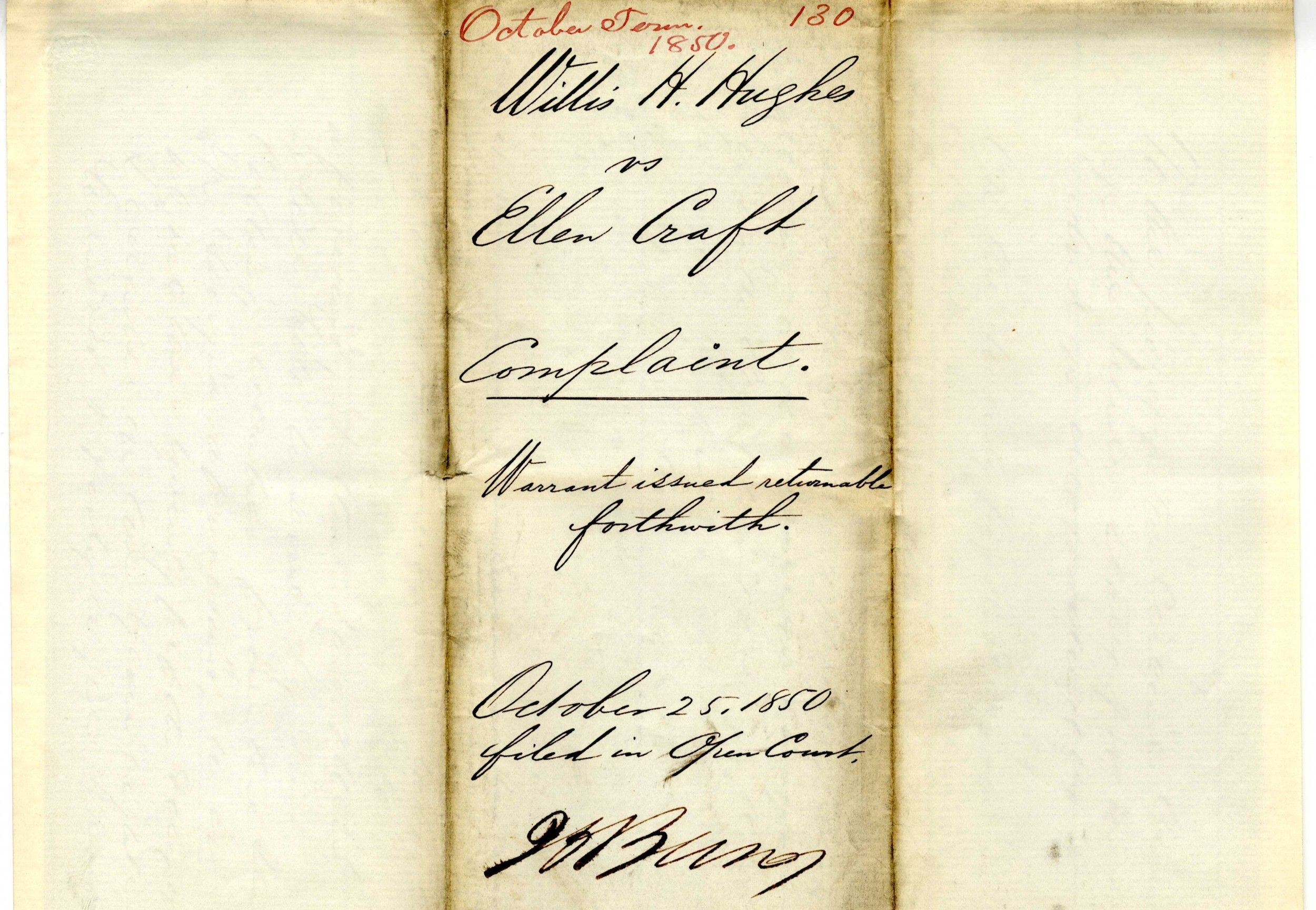
Look at the next document: a receipt showing the ownership and enslavement of William Craft.
Thomas Taylor's Receipt Regarding His Role in the Return of William Craft to Ira H. Taylor
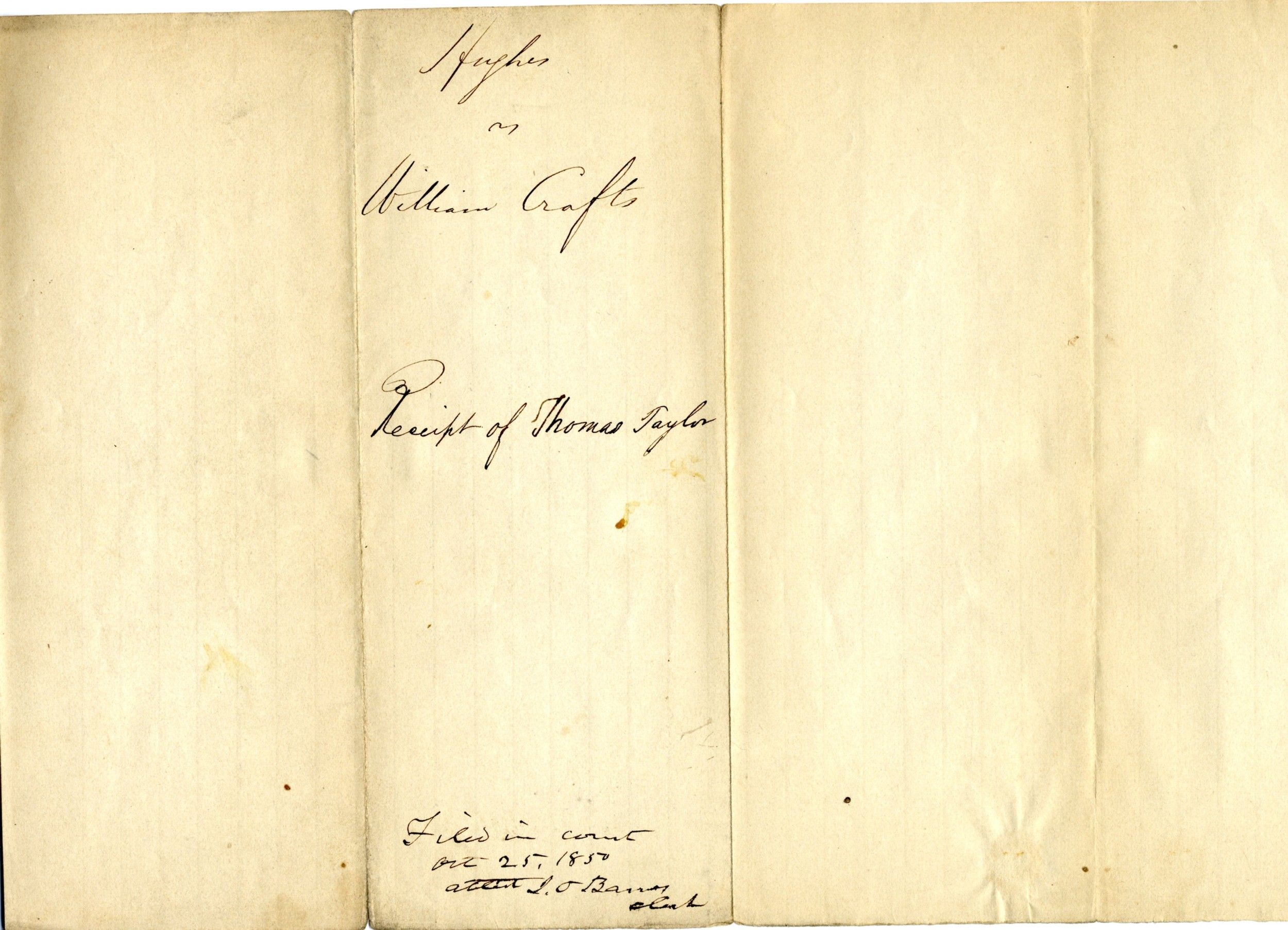
The next document is a warrant to apprehend William Craft.
Warrant to Apprehend William Craft
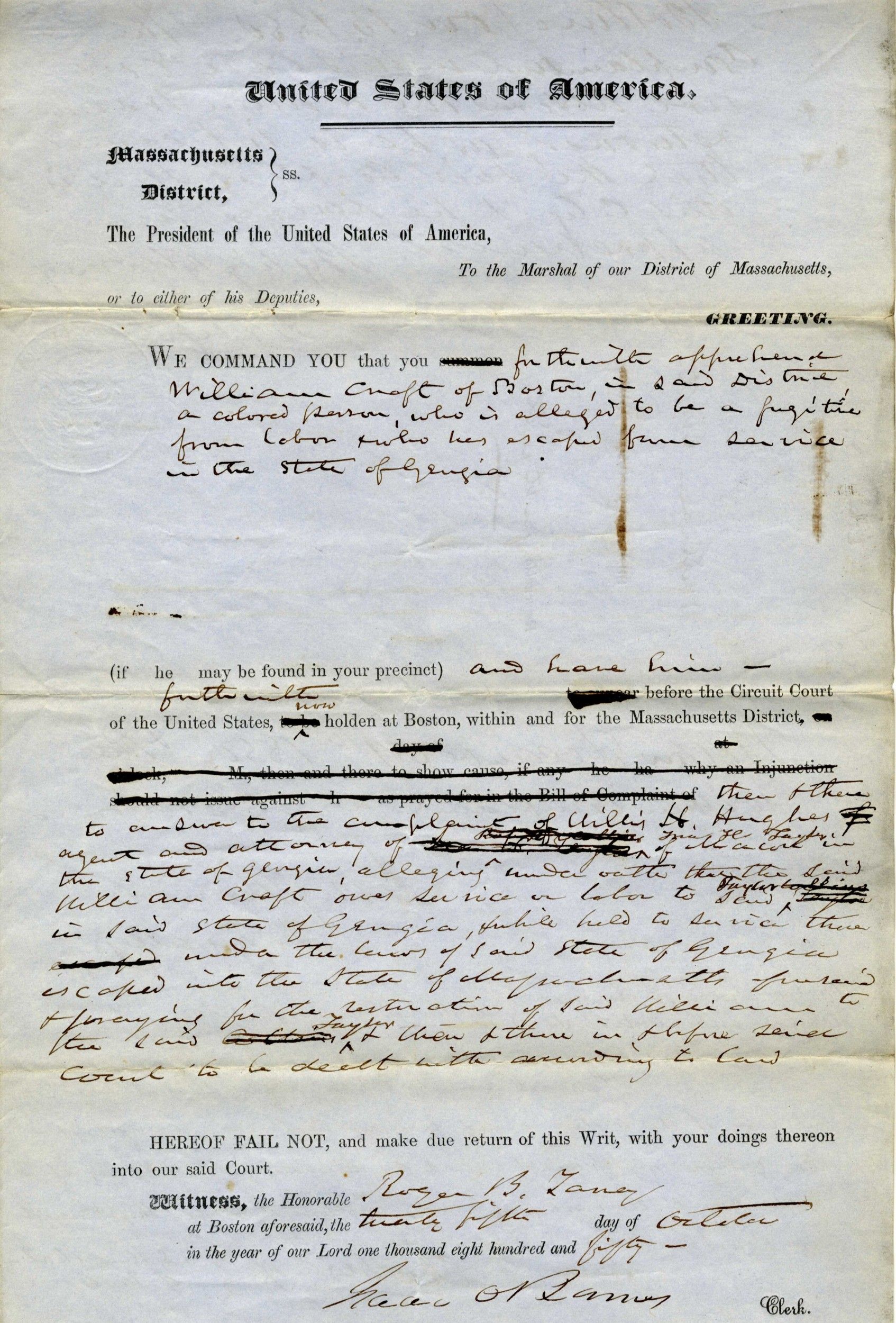
The following document explained that William "owes service and labor" to Ira H. Taylor (his former owner) in Macon, GA.
Willis H. Hughes' Complaint against William Craft

A man named John Knight swore that he knew William Craft to be "in the service" of Ira Taylor in the following document.
John Knight's Affidavit Confirming He Knew William Craft as Ira H. Taylor's Slave
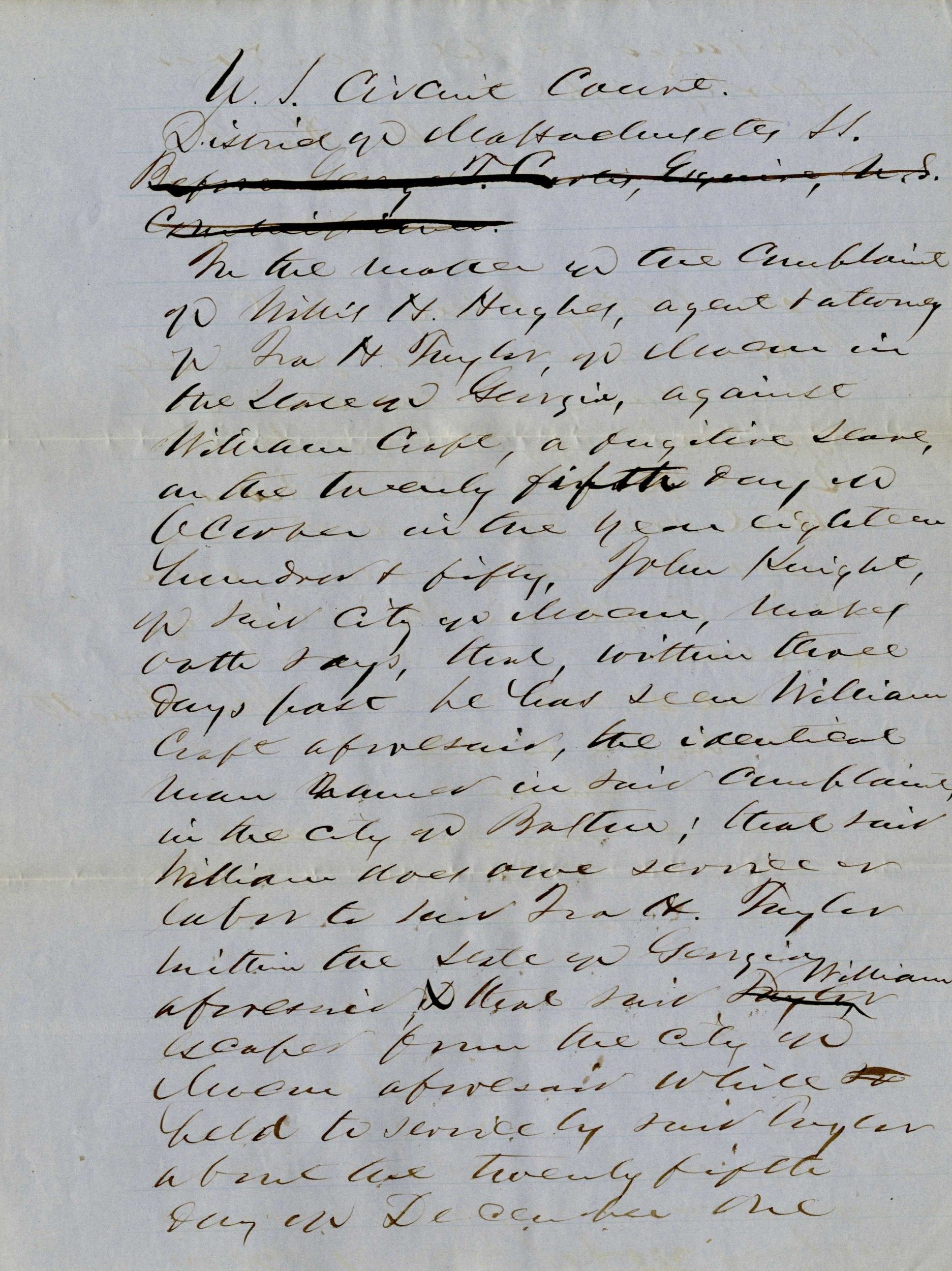
John Knight also knew Ellen Craft to be in service to Robert Collins.
John Knight's Affidavit Confirming He Knew Ellen Craft as Robert Collins' Slave
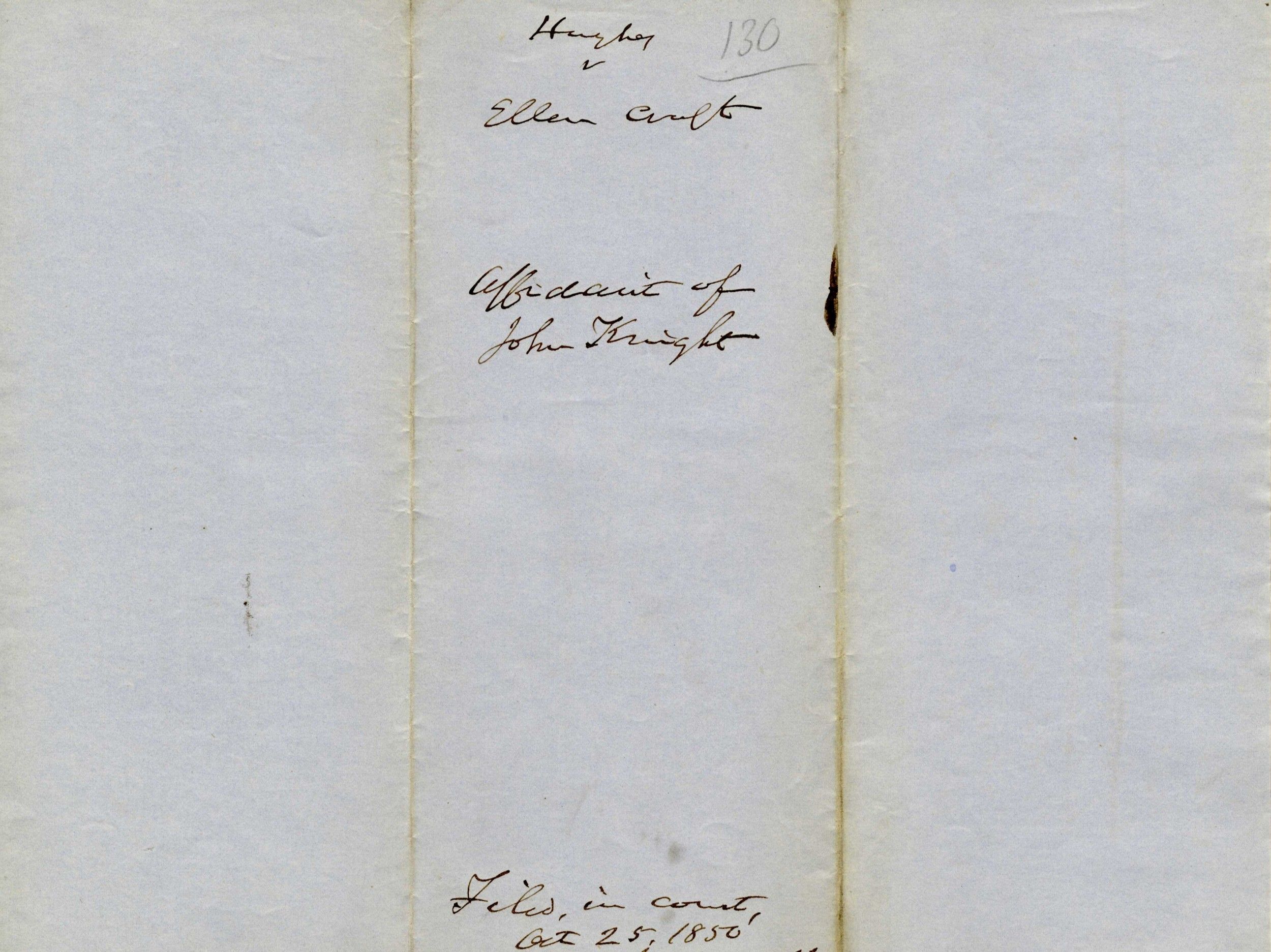
In the next document, Ellen was described by her owner Mr. Collins:
"Robert Collins of the City of Macon...saith That he is the legal owner of a bright molatto woman by the name of Ellen, commonly Called Ellen Craft, and that he has been her legal owner for about thirteen years, that she was born and raised a Slave, and that she Escaped from his house in Macon in the latter part of December 1848, and that he now understands she is residing as a fugitive slave in the State of Massachusetts, said woman Ellen is of very high complexion, low and wxxxx heavy in stature, about 22 years of age Straight hair, brown eyes, and has had a Scrofulous effection on one of her arms."
(A "scrofulous effection" is a skin problem caused by tuberculosis. It is also the origin of the word "scruffy." Ellen later said she carried her arm in a sling to disguise that she couldn't write. The record also shows that she had a bad arm.)
"Robert Collins of the City of Macon...saith That he is the legal owner of a bright molatto woman by the name of Ellen, commonly Called Ellen Craft, and that he has been her legal owner for about thirteen years, that she was born and raised a Slave, and that she Escaped from his house in Macon in the latter part of December 1848, and that he now understands she is residing as a fugitive slave in the State of Massachusetts, said woman Ellen is of very high complexion, low and wxxxx heavy in stature, about 22 years of age Straight hair, brown eyes, and has had a Scrofulous effection on one of her arms."
(A "scrofulous effection" is a skin problem caused by tuberculosis. It is also the origin of the word "scruffy." Ellen later said she carried her arm in a sling to disguise that she couldn't write. The record also shows that she had a bad arm.)
Robert Collins' Power of Attorney

The owners of Ellen and William hired Willis Hughes to act as their agent and claim their property in Boston. A deputy US Marshall sought them out at the home of Lewis Hayden, a former fugitive slave and abolition activist.
According to reports of the time, Hayden claimed they were not in his home, that he had placed gunpowder on his stoop, and that he would ignite it, if the marshall came in.
The U.S. Marshal Charles Devens filed a report, stating he had "made diligent search...and cannot find him within my precinct." (Devens later became an esteemed jurist, statesman, and Civil War general.)
According to reports of the time, Hayden claimed they were not in his home, that he had placed gunpowder on his stoop, and that he would ignite it, if the marshall came in.
The U.S. Marshal Charles Devens filed a report, stating he had "made diligent search...and cannot find him within my precinct." (Devens later became an esteemed jurist, statesman, and Civil War general.)
U.S. Marshal's Return of Writ to Apprehend William Craft

The Crafts fled to Britain, where they lived for 20 years, raising their family, lecturing about the freedom movement, and writing their memoir Running a Thousand Miles for Freedom (1860). They returned to the U.S. and settled in Georgia.
How would you tell this story?
Consider the variety of perspectives you could write from: the fugitives—Ellen or William, the owners of missing property, Lewis Hayden—who harbored and helped fugitives, the U.S. Marshall—who may have sympathized with the fugitives, the court—which had to follow the law.
Consider the variety of perspectives you could write from: the fugitives—Ellen or William, the owners of missing property, Lewis Hayden—who harbored and helped fugitives, the U.S. Marshall—who may have sympathized with the fugitives, the court—which had to follow the law.
1
Activity Element
Willis H. Hughes' Complaint Against Ellen Craft
Page 1

2
Activity Element
Thomas Taylor's Receipt Regarding His Role in the Return of William Craft to Ira H. Taylor
Page 1

3
Activity Element
Warrant to Apprehend William Craft
Page 1

4
Activity Element
Willis H. Hughes' Complaint against William Craft
Page 1

5
Activity Element
John Knight's Affidavit Confirming He Knew William Craft as Ira H. Taylor's Slave
Page 1

6
Activity Element
John Knight's Affidavit Confirming He Knew Ellen Craft as Robert Collins' Slave
Page 1

7
Activity Element
Robert Collins' Power of Attorney
Page 2

8
Activity Element
U.S. Marshal's Return of Writ to Apprehend William Craft
Page 1

Conclusion
Oh Freedom! Sought Under the Fugitive Slave Act
Making Connections
Think about the many points of view in this story: the Crafts, the "owners," the U.S. Marshal, and Lewis Hayden—who harbored fugitives. Would you have the courage to run away? To hide fugitives? To arrest them because it was the law? To take huge risks for important causes? Is it ever OK to break the law?Write a main opening statement, or topic sentence, that introduces a narrative (in either 1st or 3rd person from one of the points of view) of this story. Later you will finish your narrative telling the Crafts’ story, including quotes from the historical documents you have seen.
Your Response
Document
Willis H. Hughes' Complaint Against Ellen Craft
10/25/1850
William (1824-1900) and Ellen Craft (1826-1891) were enslaved people who escaped from their respective masters in Macon, GA, in December 1848. Ellen, the daughter of an African-American woman and a white master, passed as a white gentleman accompanied by a slave valet, William.
They made their way to Boston, MA. The Census of 1850 shows them living in freedom at the home of Lewis Hayden. In 1850, a deputy U.S. Marshall sought them out at Hayden’s home, but Hayden denied that they were there and threatened violence, such that the U.S. Marshall departed.
The Crafts fled to Britain, where they lived for 20 years, raising their family, lecturing about the freedom movement, and writing their memoir Running a Thousand Miles for Freedom (1860) (available online from Documenting the American South (DocSouth). They later returned to the United States and settled in Georgia.
They made their way to Boston, MA. The Census of 1850 shows them living in freedom at the home of Lewis Hayden. In 1850, a deputy U.S. Marshall sought them out at Hayden’s home, but Hayden denied that they were there and threatened violence, such that the U.S. Marshall departed.
The Crafts fled to Britain, where they lived for 20 years, raising their family, lecturing about the freedom movement, and writing their memoir Running a Thousand Miles for Freedom (1860) (available online from Documenting the American South (DocSouth). They later returned to the United States and settled in Georgia.
This primary source comes from the Records of District Courts of the United States.
National Archives Identifier: 7176235
Full Citation: Willis H. Hughes' Complaint Against Ellen Craft; 10/25/1850; Willis H. Hughes v. Ellen Craft; Case Files, 1790 - 1911; Records of District Courts of the United States, ; National Archives at Boston, Waltham, MA. [Online Version, https://docsteach.org/documents/document/willis-h-hughes-complaint-against-ellen-craft, April 18, 2024]Willis H. Hughes' Complaint Against Ellen Craft
Page 1
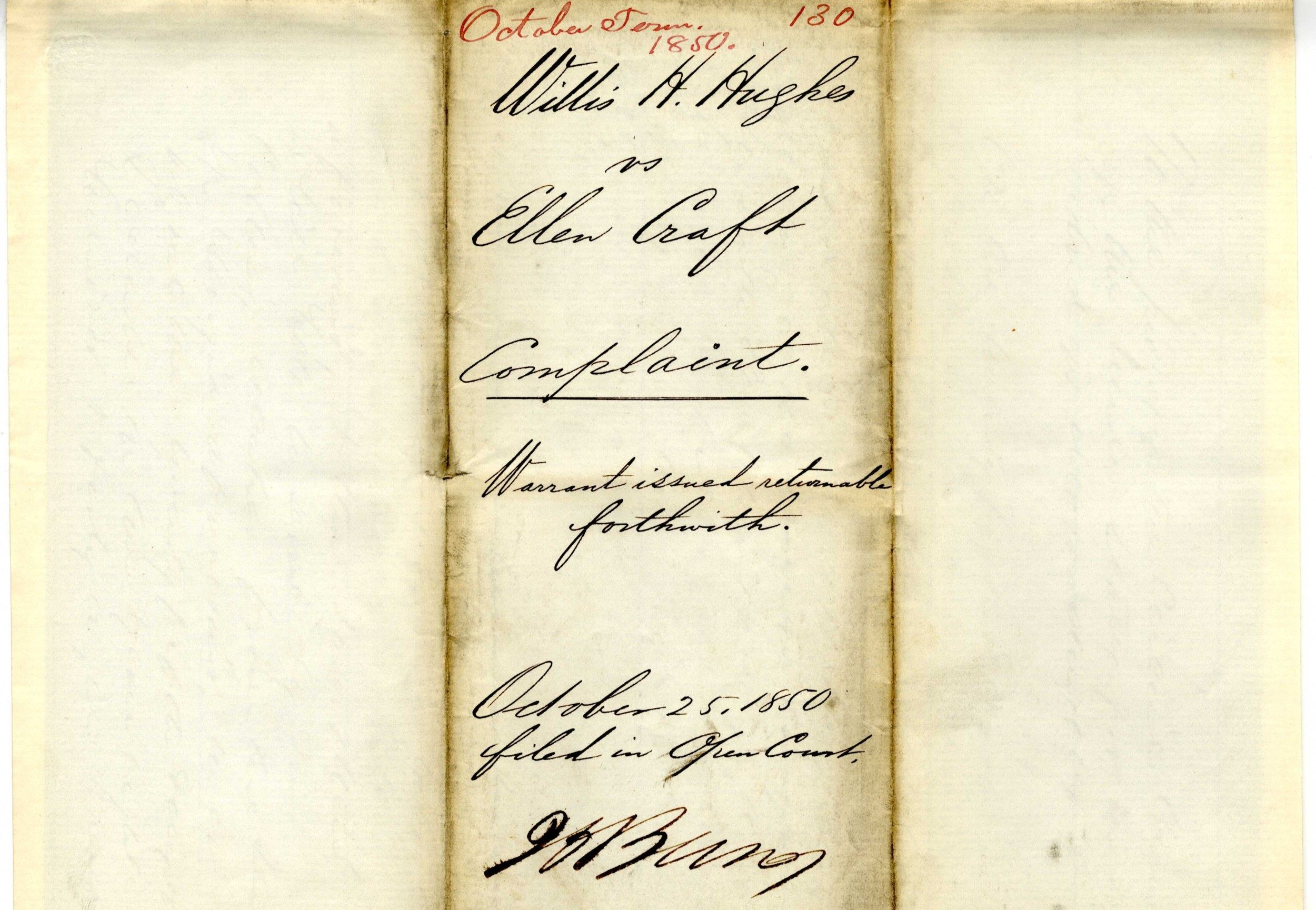
Willis H. Hughes' Complaint Against Ellen Craft
Page 2
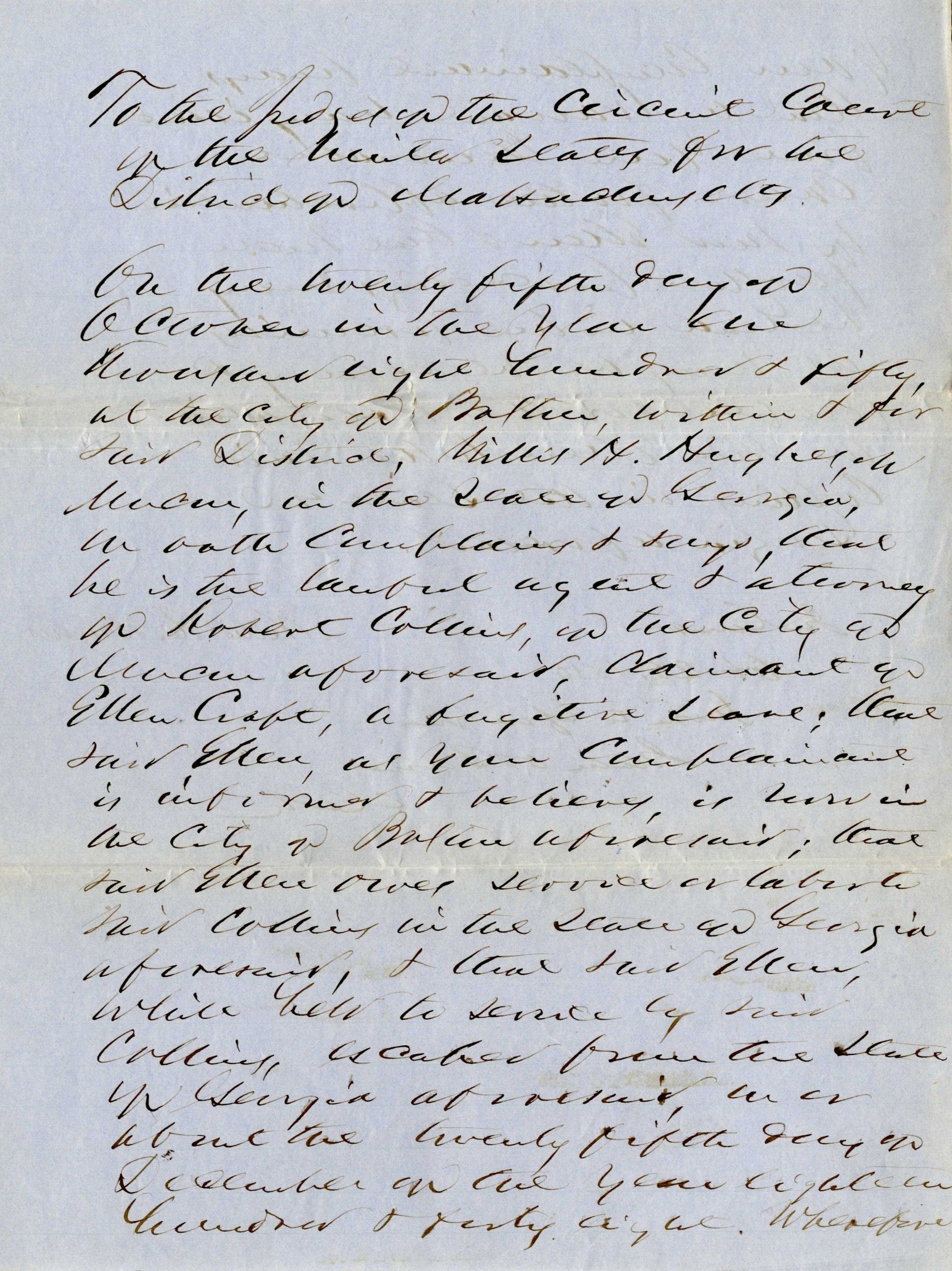
Willis H. Hughes' Complaint Against Ellen Craft
Page 3

Document
Thomas Taylor's Receipt Regarding His Role in the Return of William Craft to Ira H. Taylor
10/25/1850
William (1824-1900) and Ellen Craft (1826-1891) were enslaved people who escaped from their respective masters in Macon, GA, in December 1848. Ellen, the daughter of an African-American woman and a white master, passed as a white gentleman accompanied by a slave valet, William.
They made their way to Boston, MA. The Census of 1850 shows them living in freedom at the home of Lewis Hayden. In 1850, a deputy U.S. Marshall sought them out at Hayden’s home, but Hayden denied that they were there and threatened violence, such that the U.S. Marshall departed.
The Crafts fled to Britain, where they lived for 20 years, raising their family, lecturing about the freedom movement, and writing their memoir Running a Thousand Miles for Freedom (1860) (available online from Documenting the American South (DocSouth). They later returned to the United States and settled in Georgia.
They made their way to Boston, MA. The Census of 1850 shows them living in freedom at the home of Lewis Hayden. In 1850, a deputy U.S. Marshall sought them out at Hayden’s home, but Hayden denied that they were there and threatened violence, such that the U.S. Marshall departed.
The Crafts fled to Britain, where they lived for 20 years, raising their family, lecturing about the freedom movement, and writing their memoir Running a Thousand Miles for Freedom (1860) (available online from Documenting the American South (DocSouth). They later returned to the United States and settled in Georgia.
This primary source comes from the Records of District Courts of the United States.
National Archives Identifier: 7175327
Full Citation: Thomas Taylor's Receipt Regarding His Role in the Return of William Craft to Ira H. Taylor; 10/25/1850; Willis H. Hughes v. William Craft; Case Files, 1790 - 1911; Records of District Courts of the United States, ; National Archives at Boston, Waltham, MAl. [Online Version, https://docsteach.org/documents/document/thomas-taylors-receipt-regarding-his-role-in-the-return-of-william-craft-to-ira-h-taylor, April 18, 2024]Thomas Taylor's Receipt Regarding His Role in the Return of William Craft to Ira H. Taylor
Page 1
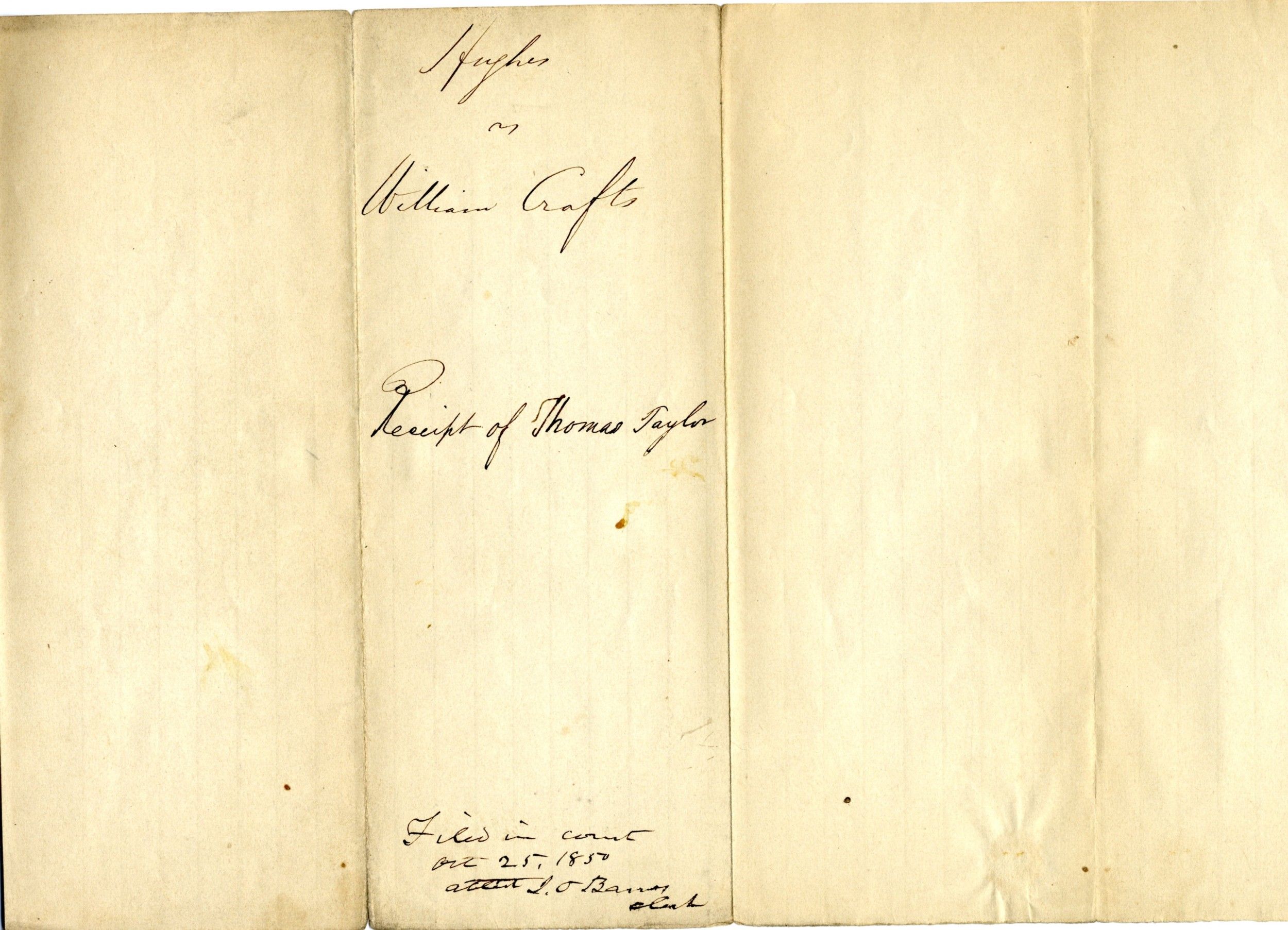
Thomas Taylor's Receipt Regarding His Role in the Return of William Craft to Ira H. Taylor
Page 2
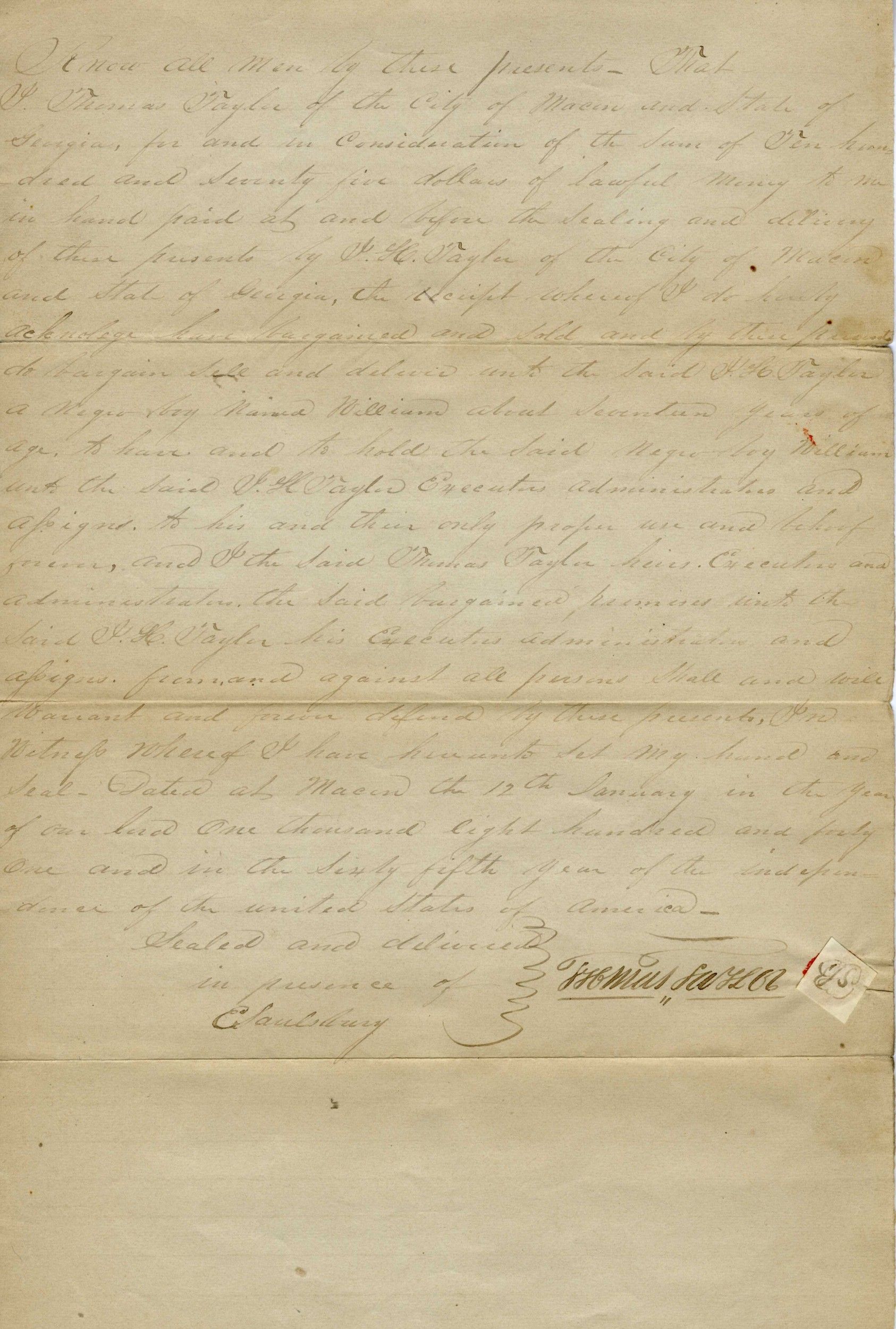
Document
Warrant to Apprehend William Craft
10/25/1850
William (1824-1900) and Ellen Craft (1826-1891) were enslaved people who escaped from their respective masters in Macon, GA, in December 1848. Ellen, the daughter of an African-American woman and a white master, passed as a white gentleman accompanied by a slave valet, William.
They made their way to Boston, MA. The Census of 1850 shows them living in freedom at the home of Lewis Hayden. In 1850, a deputy U.S. Marshall sought them out at Hayden’s home, but Hayden denied that they were there and threatened violence, such that the U.S. Marshall departed.
The Crafts fled to Britain, where they lived for 20 years, raising their family, lecturing about the freedom movement, and writing their memoir Running a Thousand Miles for Freedom (1860) (available online from Documenting the American South (DocSouth). They later returned to the United States and settled in Georgia.
They made their way to Boston, MA. The Census of 1850 shows them living in freedom at the home of Lewis Hayden. In 1850, a deputy U.S. Marshall sought them out at Hayden’s home, but Hayden denied that they were there and threatened violence, such that the U.S. Marshall departed.
The Crafts fled to Britain, where they lived for 20 years, raising their family, lecturing about the freedom movement, and writing their memoir Running a Thousand Miles for Freedom (1860) (available online from Documenting the American South (DocSouth). They later returned to the United States and settled in Georgia.
This primary source comes from the Records of District Courts of the United States.
National Archives Identifier: 7174817
Full Citation: Warrant to Apprehend William Craft; 10/25/1850; Willis H. Hughes v. William Craft; Case Files, 1790 - 1911; Records of District Courts of the United States, ; National Archives at Boston, Waltham, MA. [Online Version, https://docsteach.org/documents/document/warrant-to-apprehend-william-craft, April 18, 2024]Warrant to Apprehend William Craft
Page 1
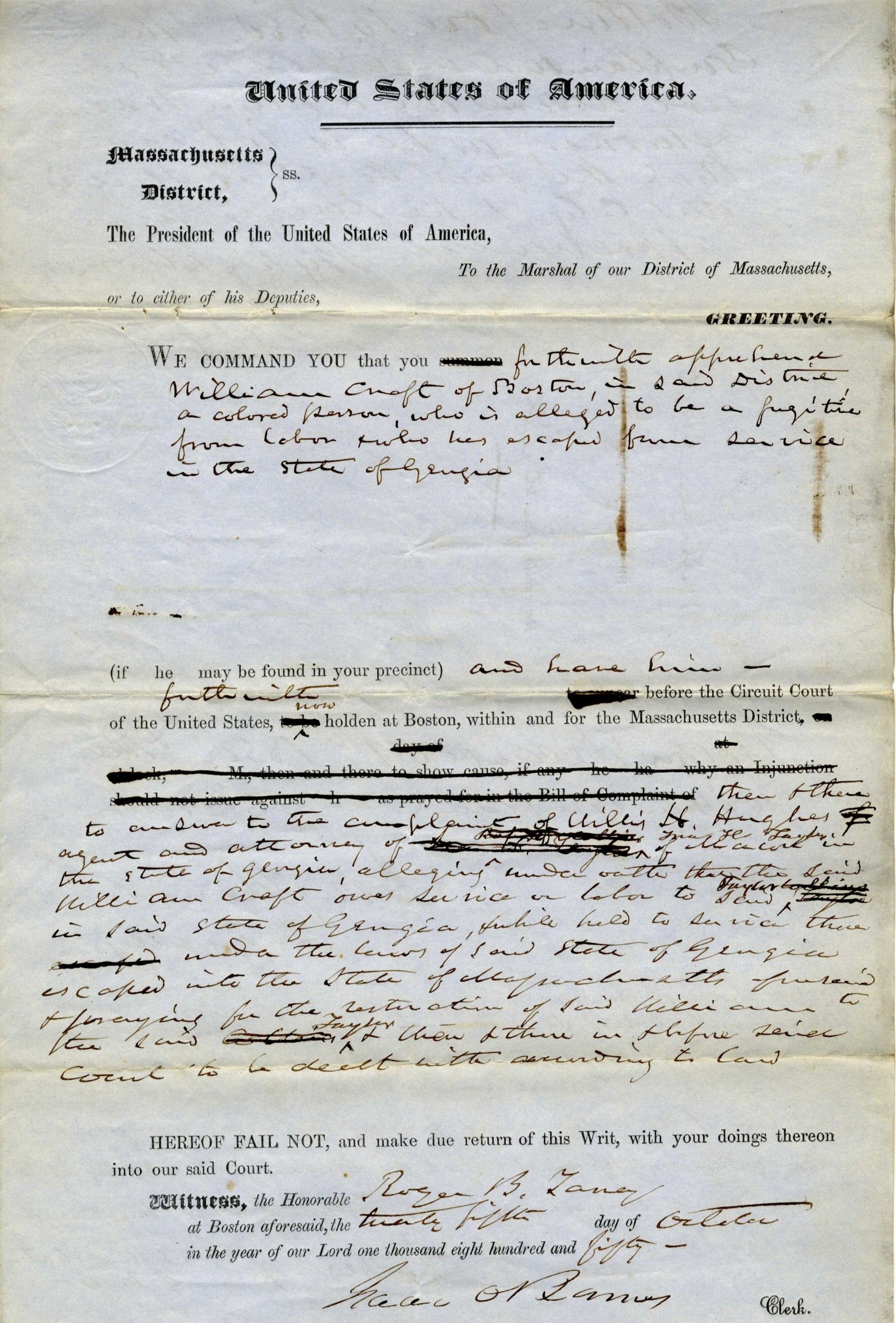
Warrant to Apprehend William Craft
Page 2
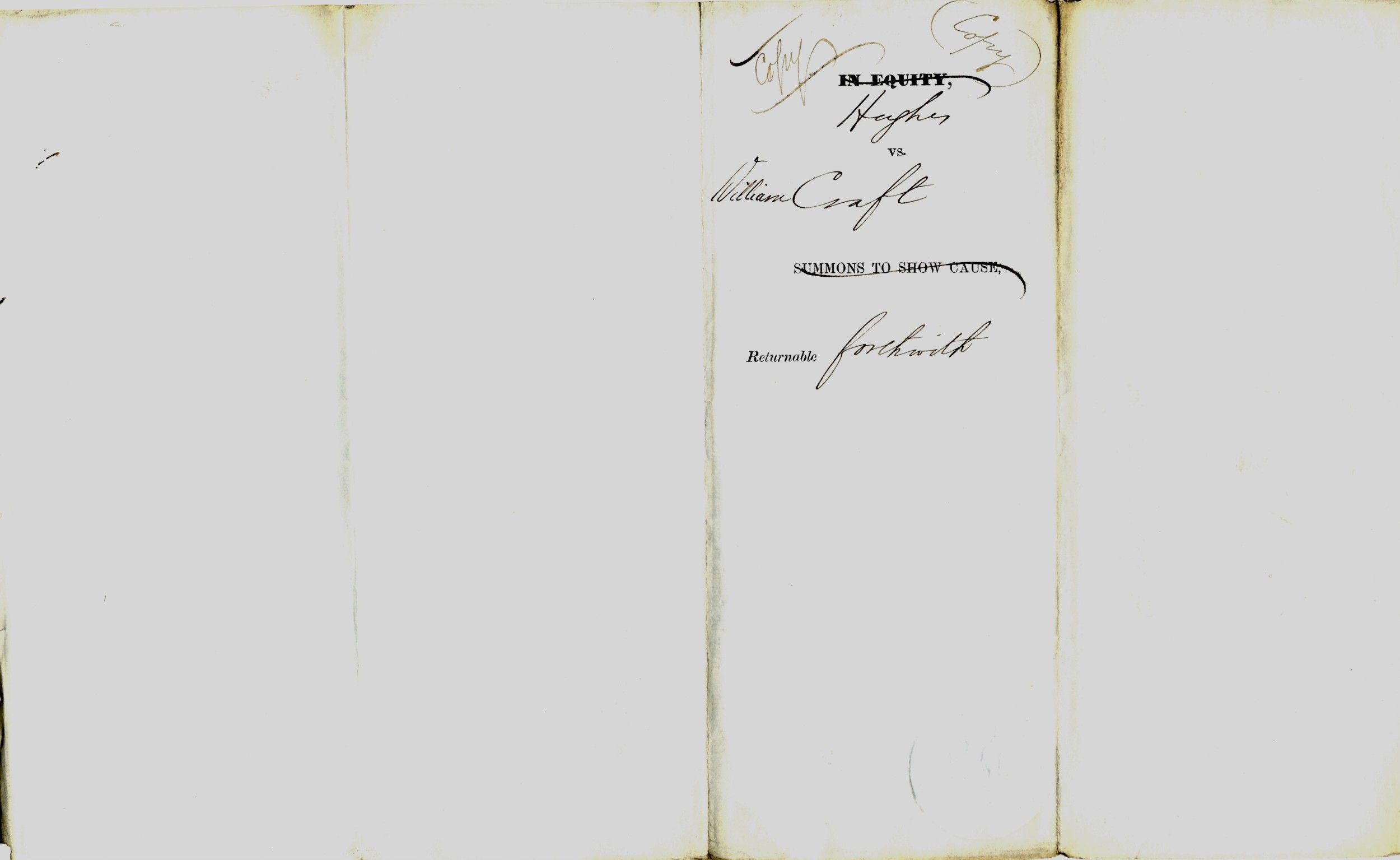
Document
Willis H. Hughes' Complaint against William Craft
10/25/1850
William (1824-1900) and Ellen Craft (1826-1891) were enslaved people who escaped from their respective masters in Macon, GA, in December 1848. Ellen, the daughter of an African-American woman and a white master, passed as a white gentleman accompanied by a slave valet, William.
They made their way to Boston, MA. The Census of 1850 shows them living in freedom at the home of Lewis Hayden. In 1850, a deputy U.S. Marshall sought them out at Hayden’s home, but Hayden denied that they were there and threatened violence, such that the U.S. Marshall departed.
The Crafts fled to Britain, where they lived for 20 years, raising their family, lecturing about the freedom movement, and writing their memoir Running a Thousand Miles for Freedom (1860) (available online from Documenting the American South (DocSouth). They later returned to the United States and settled in Georgia.
They made their way to Boston, MA. The Census of 1850 shows them living in freedom at the home of Lewis Hayden. In 1850, a deputy U.S. Marshall sought them out at Hayden’s home, but Hayden denied that they were there and threatened violence, such that the U.S. Marshall departed.
The Crafts fled to Britain, where they lived for 20 years, raising their family, lecturing about the freedom movement, and writing their memoir Running a Thousand Miles for Freedom (1860) (available online from Documenting the American South (DocSouth). They later returned to the United States and settled in Georgia.
This primary source comes from the Records of District Courts of the United States.
National Archives Identifier: 7175296
Full Citation: Willis H. Hughes' Complaint against William Craft; 10/25/1850; Willis H. Hughes v. William Craft; Case Files, 1790 - 1911; Records of District Courts of the United States, ; National Archives at Boston, Waltham, MA. [Online Version, https://docsteach.org/documents/document/willis-h-hughes-complaint-against-william-craft, April 18, 2024]Willis H. Hughes' Complaint against William Craft
Page 1
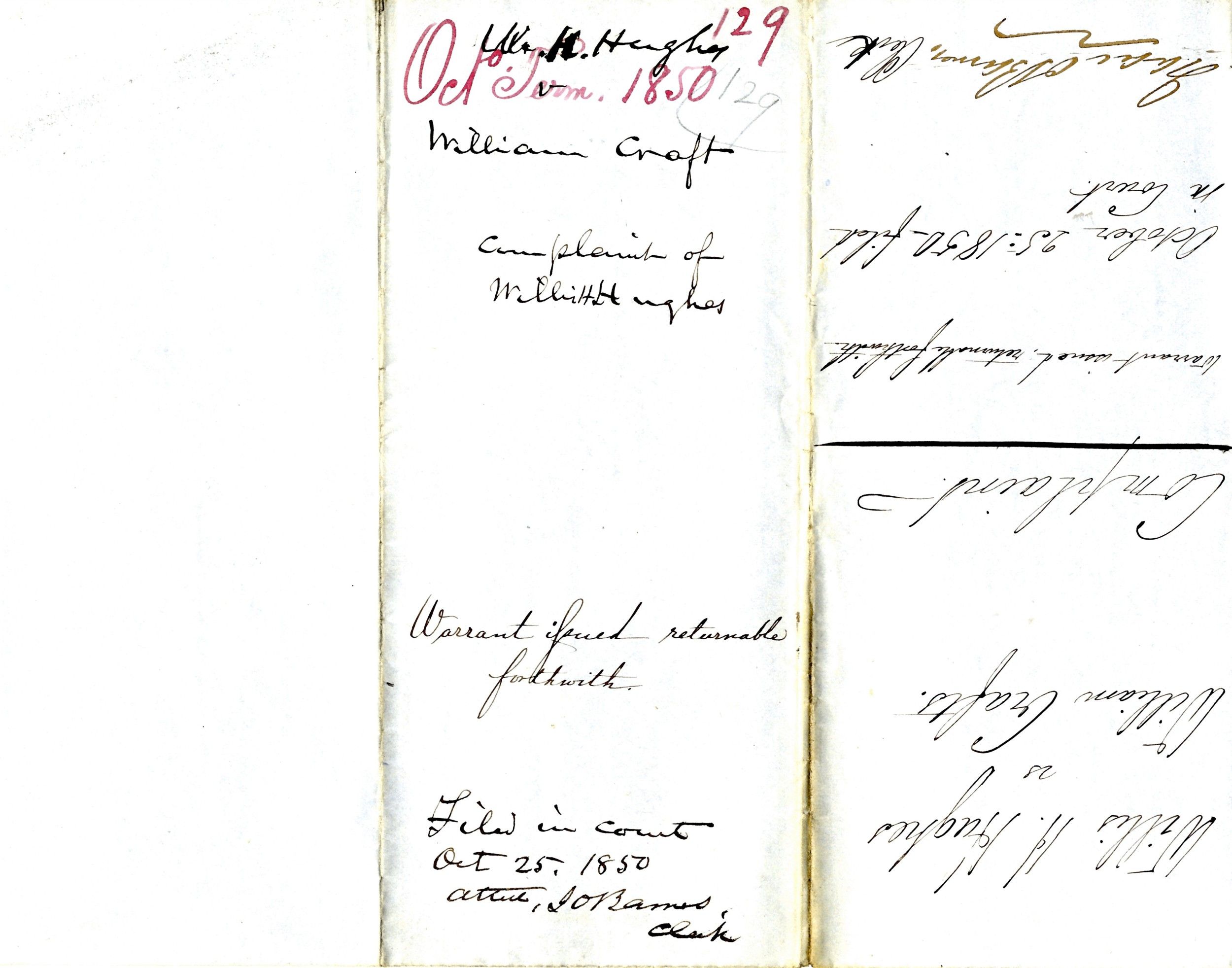
Willis H. Hughes' Complaint against William Craft
Page 2
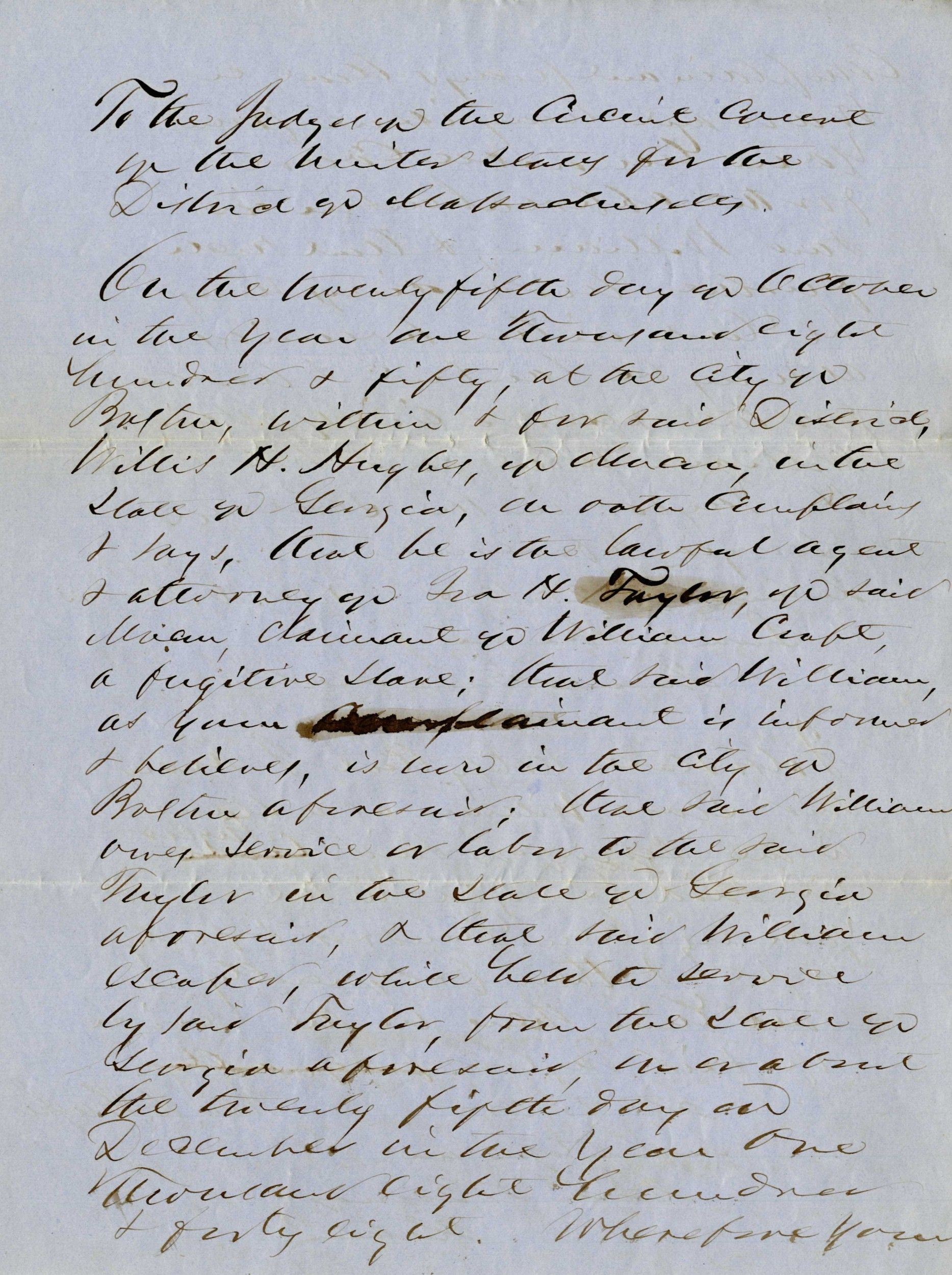
Willis H. Hughes' Complaint against William Craft
Page 3
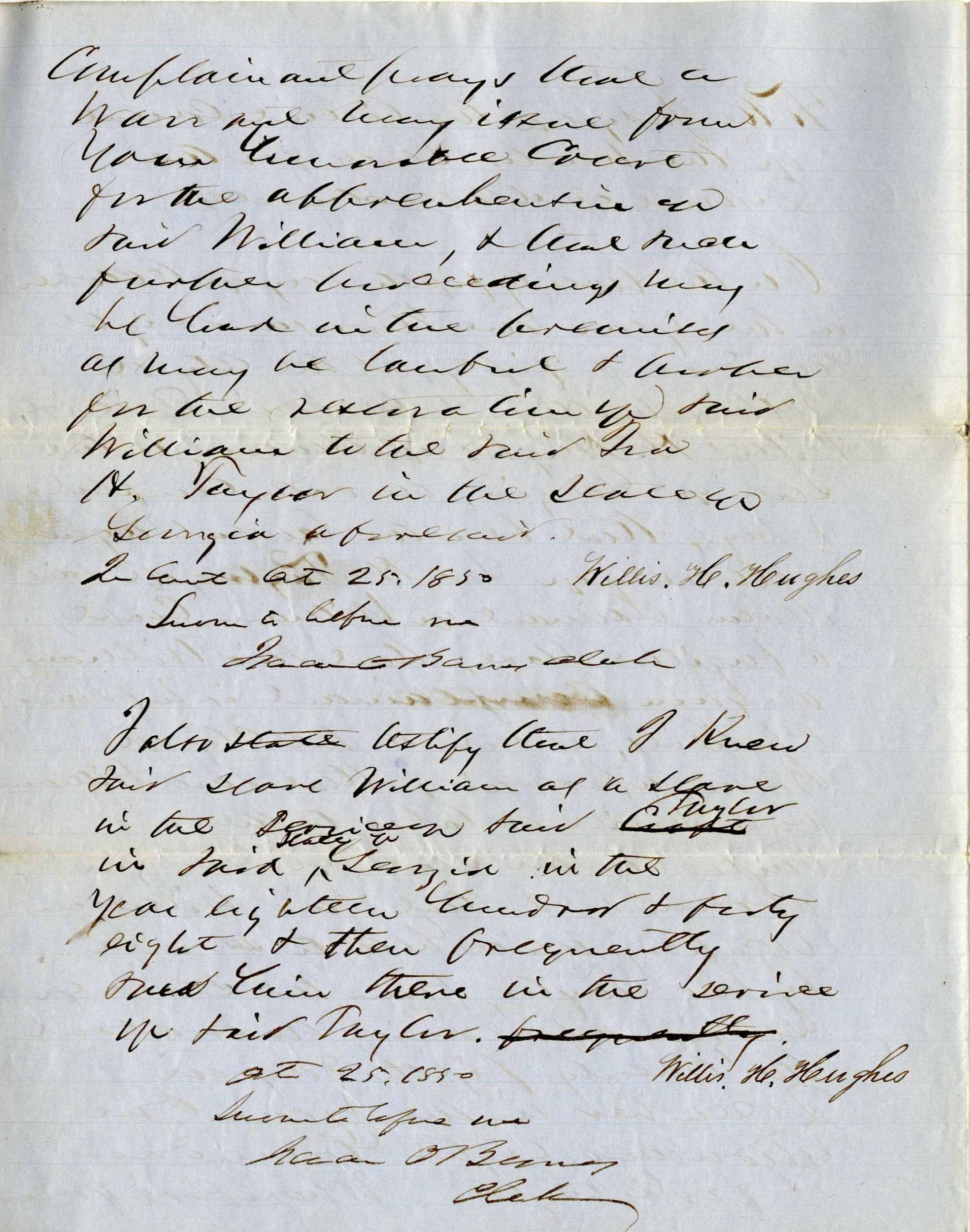
Document
John Knight's Affidavit Confirming He Knew William Craft as Ira H. Taylor's Slave
10/25/1850
William (1824-1900) and Ellen Craft (1826-1891) were enslaved people who escaped from their respective masters in Macon, GA, in December 1848. Ellen, the daughter of an African-American woman and a white master, passed as a white gentleman accompanied by a slave valet, William.
They made their way to Boston, MA. The Census of 1850 shows them living in freedom at the home of Lewis Hayden. In 1850, a deputy U.S. Marshall sought them out at Hayden’s home, but Hayden denied that they were there and threatened violence, such that the U.S. Marshall departed.
The Crafts fled to Britain, where they lived for 20 years, raising their family, lecturing about the freedom movement, and writing their memoir Running a Thousand Miles for Freedom (1860) (available online from Documenting the American South (DocSouth). They later returned to the United States and settled in Georgia.
The Crafts fled to Britain, where they lived for 20 years, raising their family, lecturing about the freedom movement, and writing their memoir Running a Thousand Miles for Freedom (1860) (available online from Documenting the American South (DocSouth). They later returned to the United States and settled in Georgia.
This primary source comes from the Records of District Courts of the United States.
National Archives Identifier: 7175113
Full Citation: John Knight's Affidavit Confirming He Knew William Craft as Ira H. Taylor's Slave; 10/25/1850; Willis H. Hughes v. William Craft; Case Files, 1790 - 1911; Records of District Courts of the United States, ; National Archives at Boston, Waltham, MA. [Online Version, https://docsteach.org/documents/document/john-knights-affidavit-confirming-he-knew-william-craft-as-ira-h-taylors-slave, April 18, 2024]John Knight's Affidavit Confirming He Knew William Craft as Ira H. Taylor's Slave
Page 1
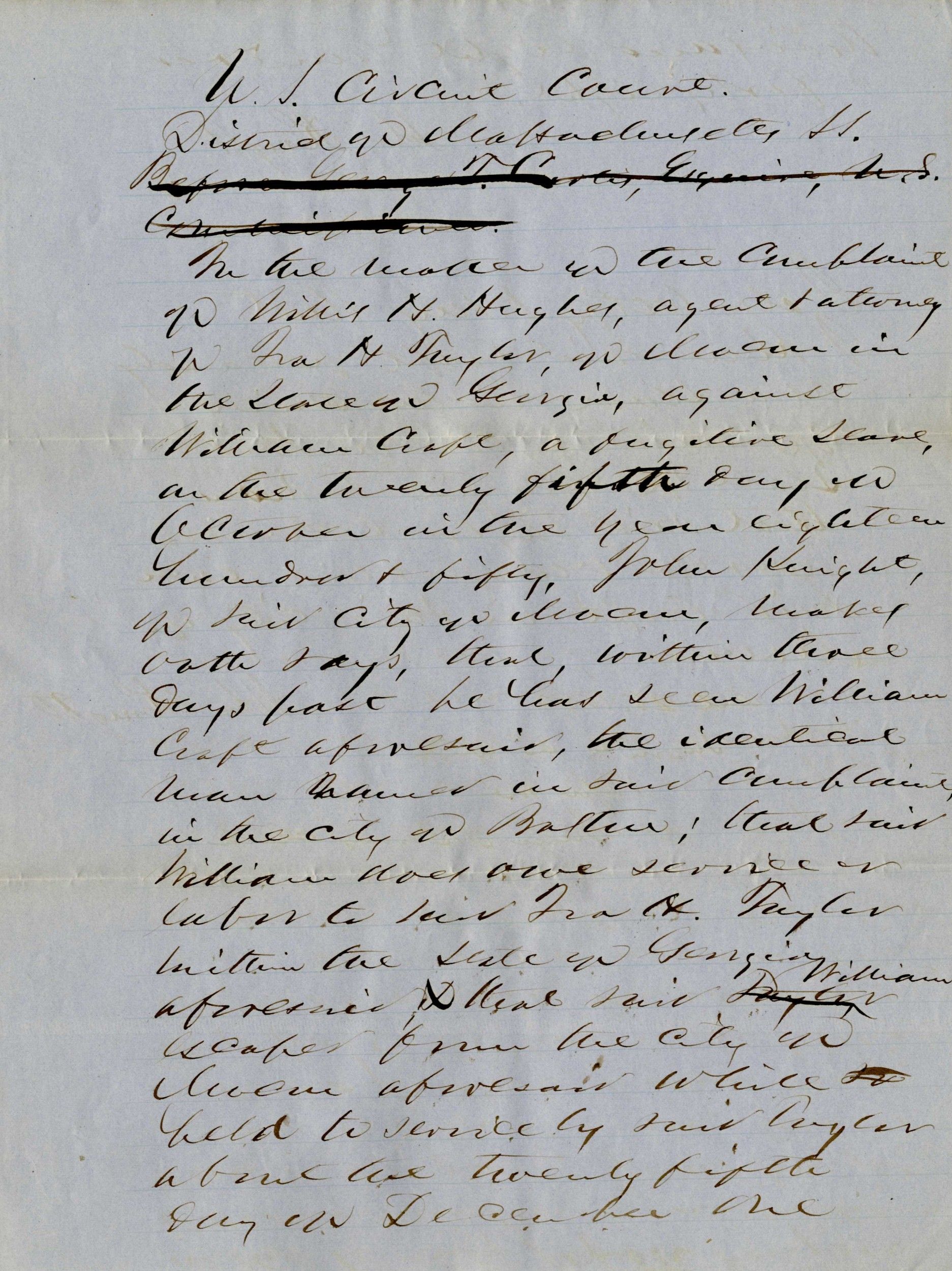
John Knight's Affidavit Confirming He Knew William Craft as Ira H. Taylor's Slave
Page 2
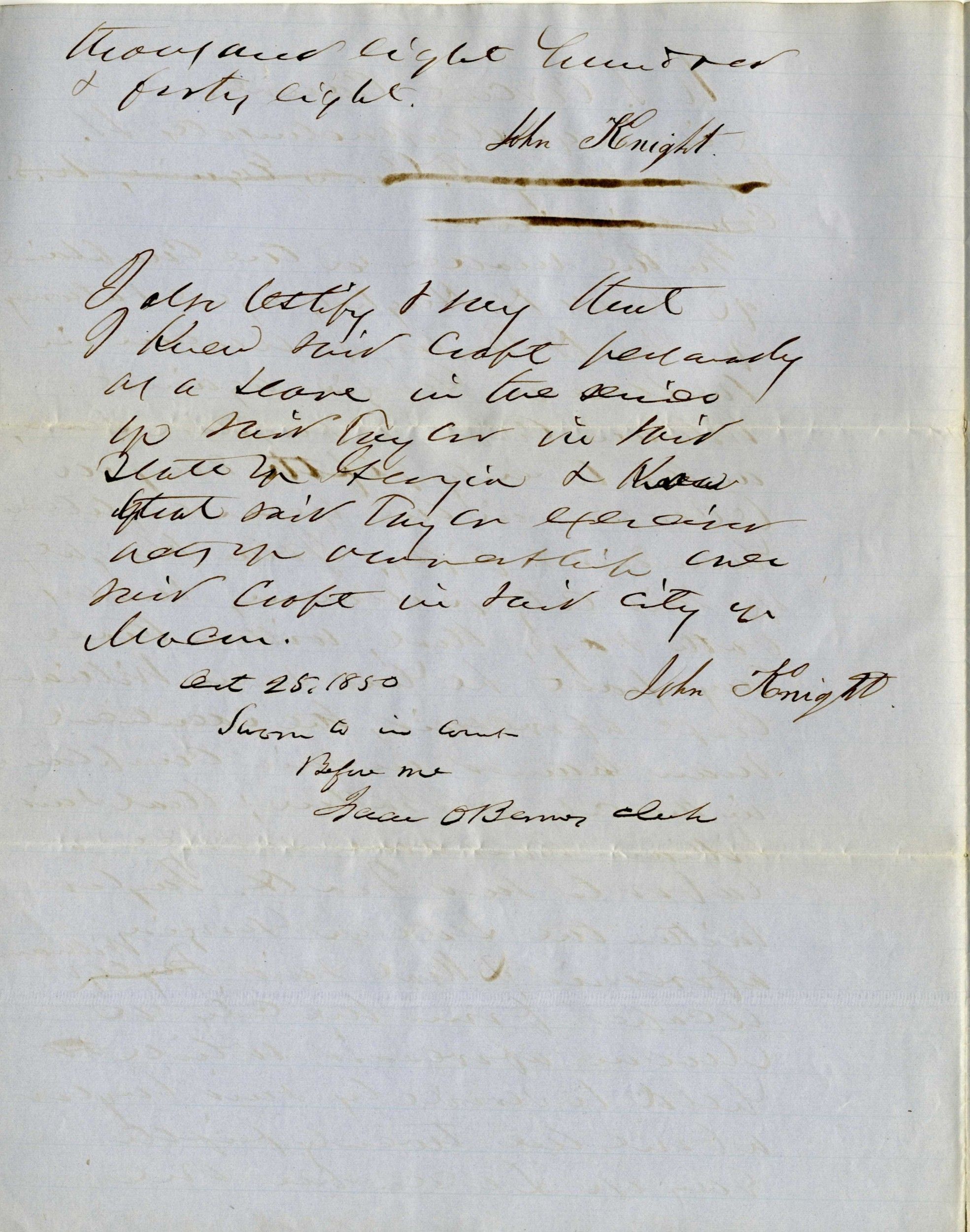
John Knight's Affidavit Confirming He Knew William Craft as Ira H. Taylor's Slave
Page 3
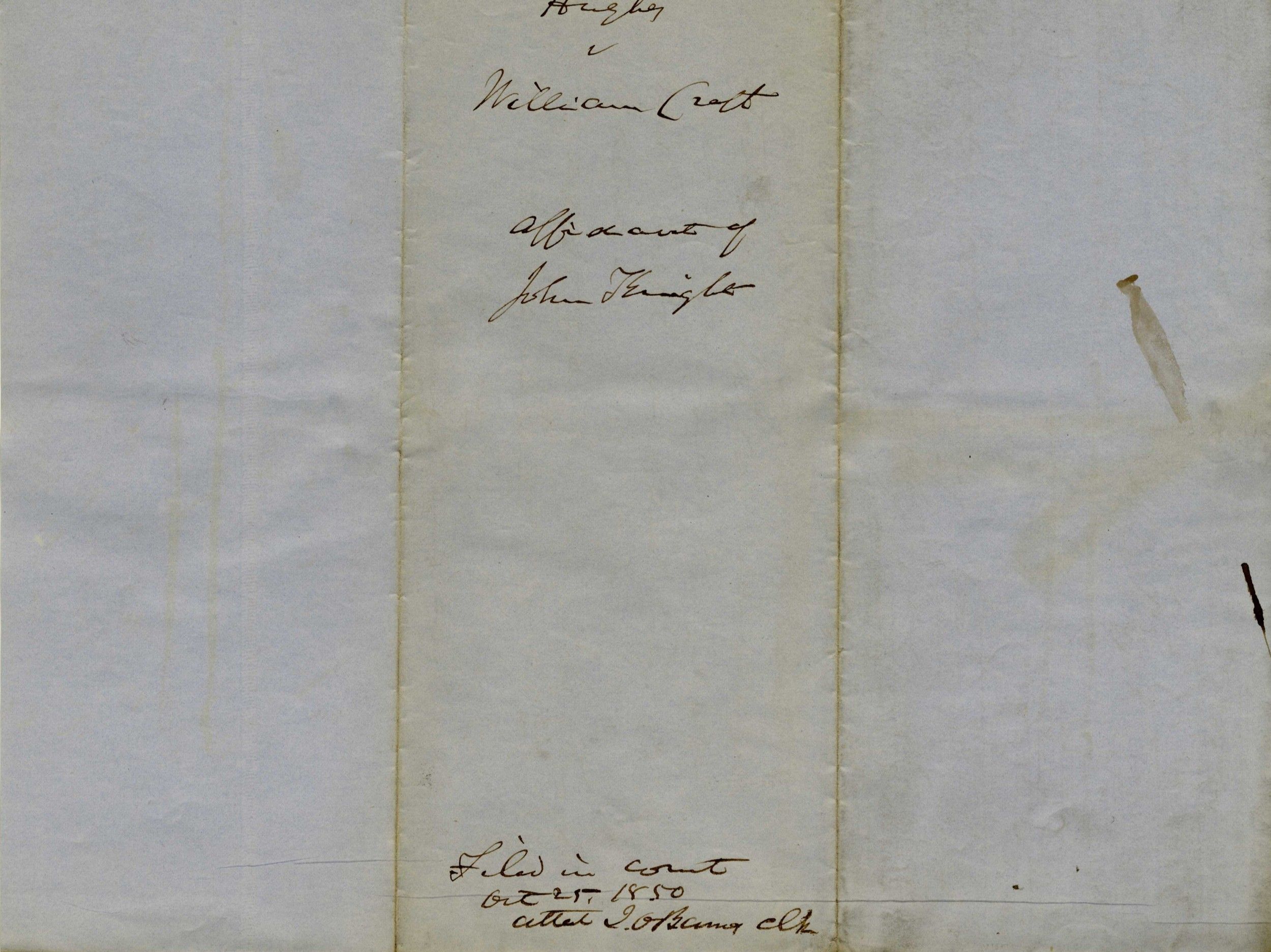
Document
John Knight's Affidavit Confirming He Knew Ellen Craft as Robert Collins' Slave
10/25/1850
William (1824-1900) and Ellen Craft (1826-1891) were enslaved people who escaped from their respective masters in Macon, GA, in December 1848. Ellen, the daughter of an African-American woman and a white master, passed as a white gentleman accompanied by a slave valet, William.
They made their way to Boston, MA. The Census of 1850 shows them living in freedom at the home of Lewis Hayden. In 1850, a deputy U.S. Marshall sought them out at Hayden’s home, but Hayden denied that they were there and threatened violence, such that the U.S. Marshall departed.
The Crafts fled to Britain, where they lived for 20 years, raising their family, lecturing about the freedom movement, and writing their memoir Running a Thousand Miles for Freedom (1860) (available online from Documenting the American South (DocSouth). They later returned to the United States and settled in Georgia.
They made their way to Boston, MA. The Census of 1850 shows them living in freedom at the home of Lewis Hayden. In 1850, a deputy U.S. Marshall sought them out at Hayden’s home, but Hayden denied that they were there and threatened violence, such that the U.S. Marshall departed.
The Crafts fled to Britain, where they lived for 20 years, raising their family, lecturing about the freedom movement, and writing their memoir Running a Thousand Miles for Freedom (1860) (available online from Documenting the American South (DocSouth). They later returned to the United States and settled in Georgia.
This primary source comes from the Records of District Courts of the United States.
National Archives Identifier: 7176100
Full Citation: John Knight's Affidavit Confirming He Knew Ellen Craft as Robert Collins' Slave; 10/25/1850; Willis H. Hughes v. Ellen Craft; Case Files, 1790 - 1911; Records of District Courts of the United States, ; National Archives at Boston, Waltham, MA. [Online Version, https://docsteach.org/documents/document/john-knight-affidavit, April 18, 2024]John Knight's Affidavit Confirming He Knew Ellen Craft as Robert Collins' Slave
Page 1
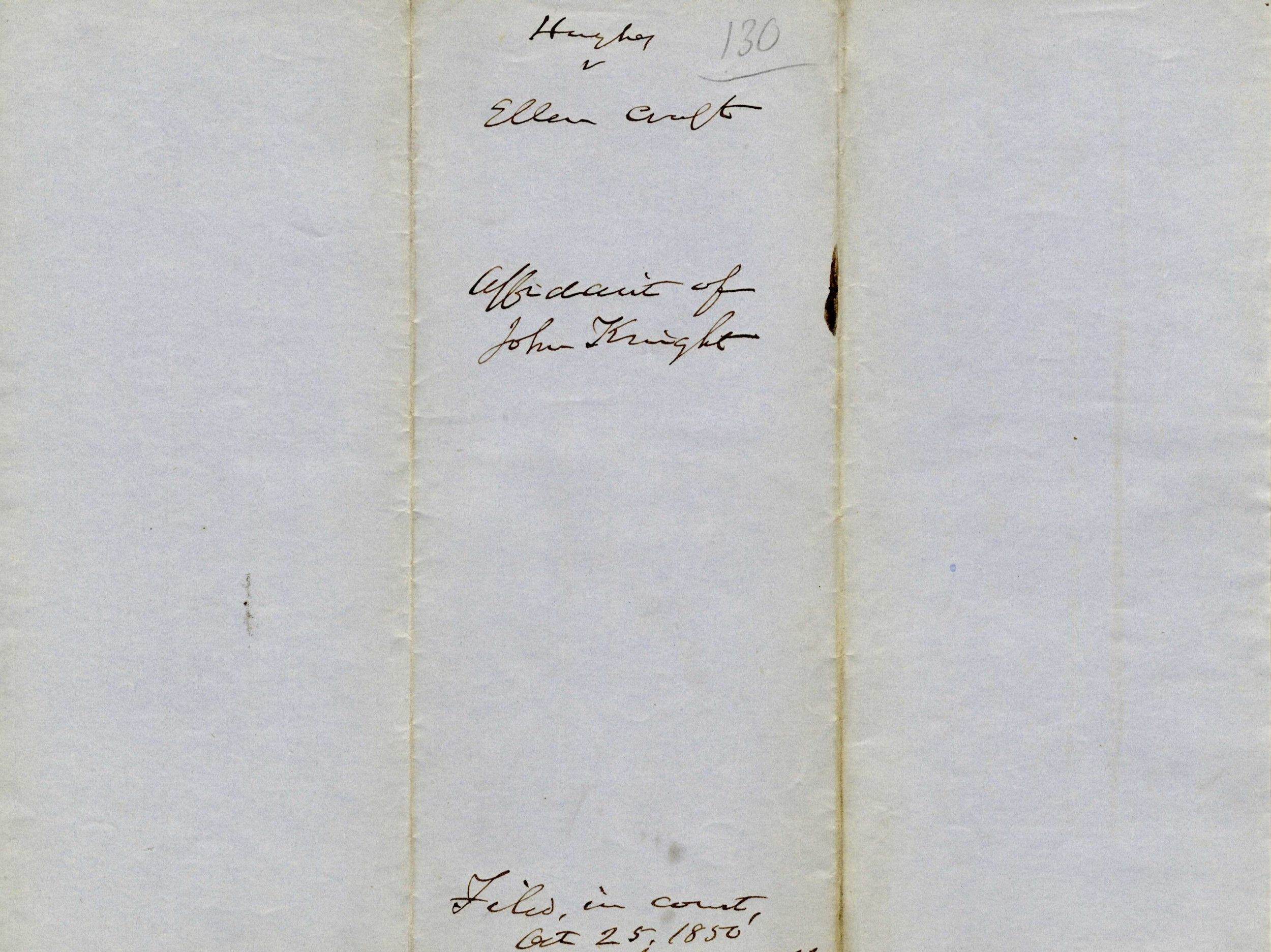
John Knight's Affidavit Confirming He Knew Ellen Craft as Robert Collins' Slave
Page 2
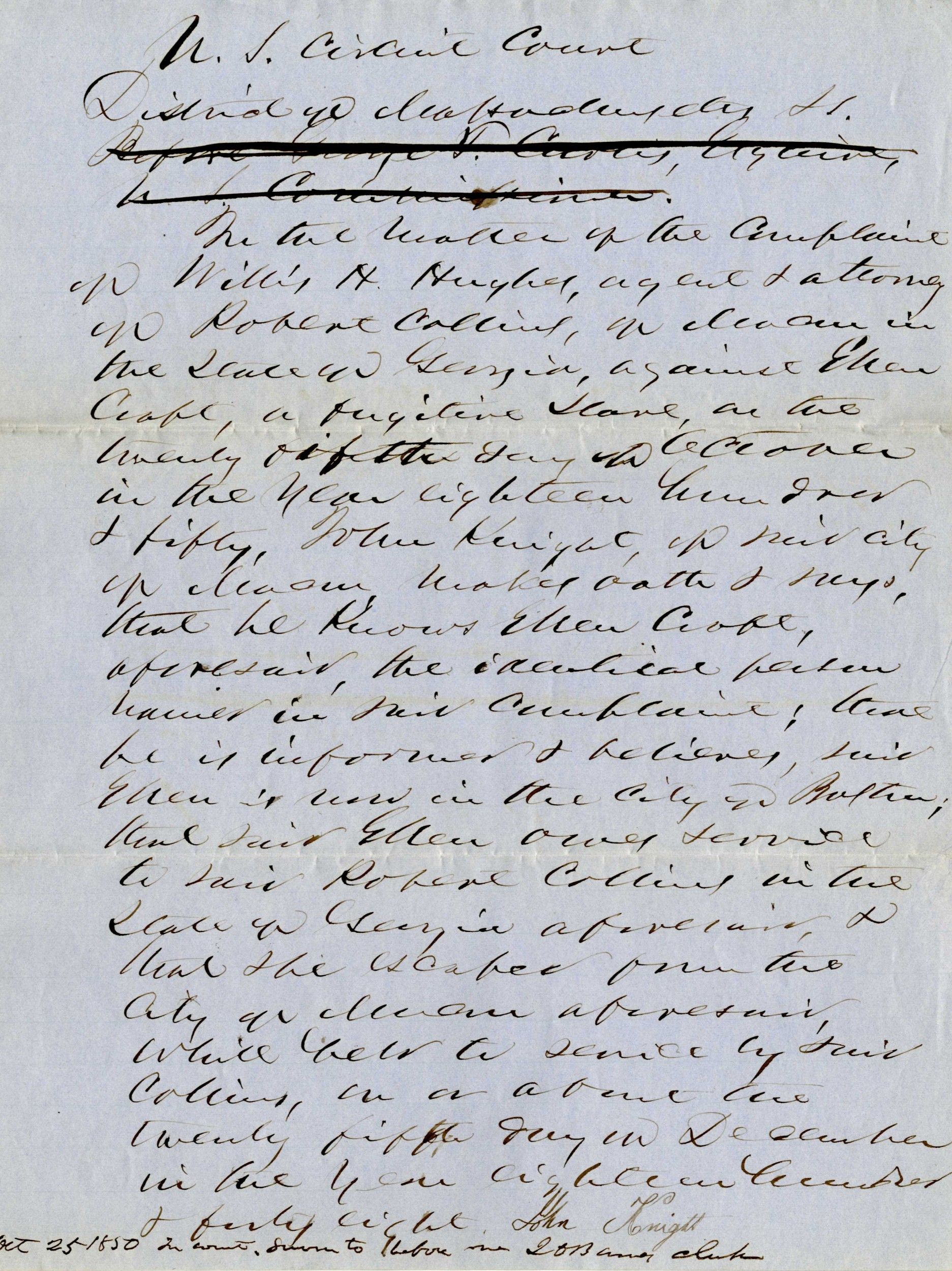
Document
Robert Collins' Power of Attorney
10/11/1850
William (1824-1900) and Ellen Craft (1826-1891) were enslaved people who escaped from their respective masters in Macon, GA, in December 1848. Ellen, the daughter of an African-American woman and a white master, passed as a white gentleman accompanied by a slave valet, William.
They made their way to Boston, MA. The Census of 1850 shows them living in freedom at the home of Lewis Hayden. In 1850, a deputy U.S. Marshall sought them out at Hayden’s home, but Hayden denied that they were there and threatened violence, such that the U.S. Marshall departed.
The Crafts fled to Britain, where they lived for 20 years, raising their family, lecturing about the freedom movement, and writing their memoir Running a Thousand Miles for Freedom (1860) (available online from Documenting the American South (DocSouth). They later returned to the United States and settled in Georgia.
They made their way to Boston, MA. The Census of 1850 shows them living in freedom at the home of Lewis Hayden. In 1850, a deputy U.S. Marshall sought them out at Hayden’s home, but Hayden denied that they were there and threatened violence, such that the U.S. Marshall departed.
The Crafts fled to Britain, where they lived for 20 years, raising their family, lecturing about the freedom movement, and writing their memoir Running a Thousand Miles for Freedom (1860) (available online from Documenting the American South (DocSouth). They later returned to the United States and settled in Georgia.
This primary source comes from the Records of District Courts of the United States.
National Archives Identifier: 7176323
Full Citation: Robert Collins' Power of Attorney; 10/11/1850; Willis H. Hughes v. Ellen Craft; Case Files, 1790 - 1911; Records of District Courts of the United States, ; National Archives at Boston, Waltham, MA. [Online Version, https://docsteach.org/documents/document/robert-collins-power-of-attorney, April 18, 2024]Robert Collins' Power of Attorney
Page 1
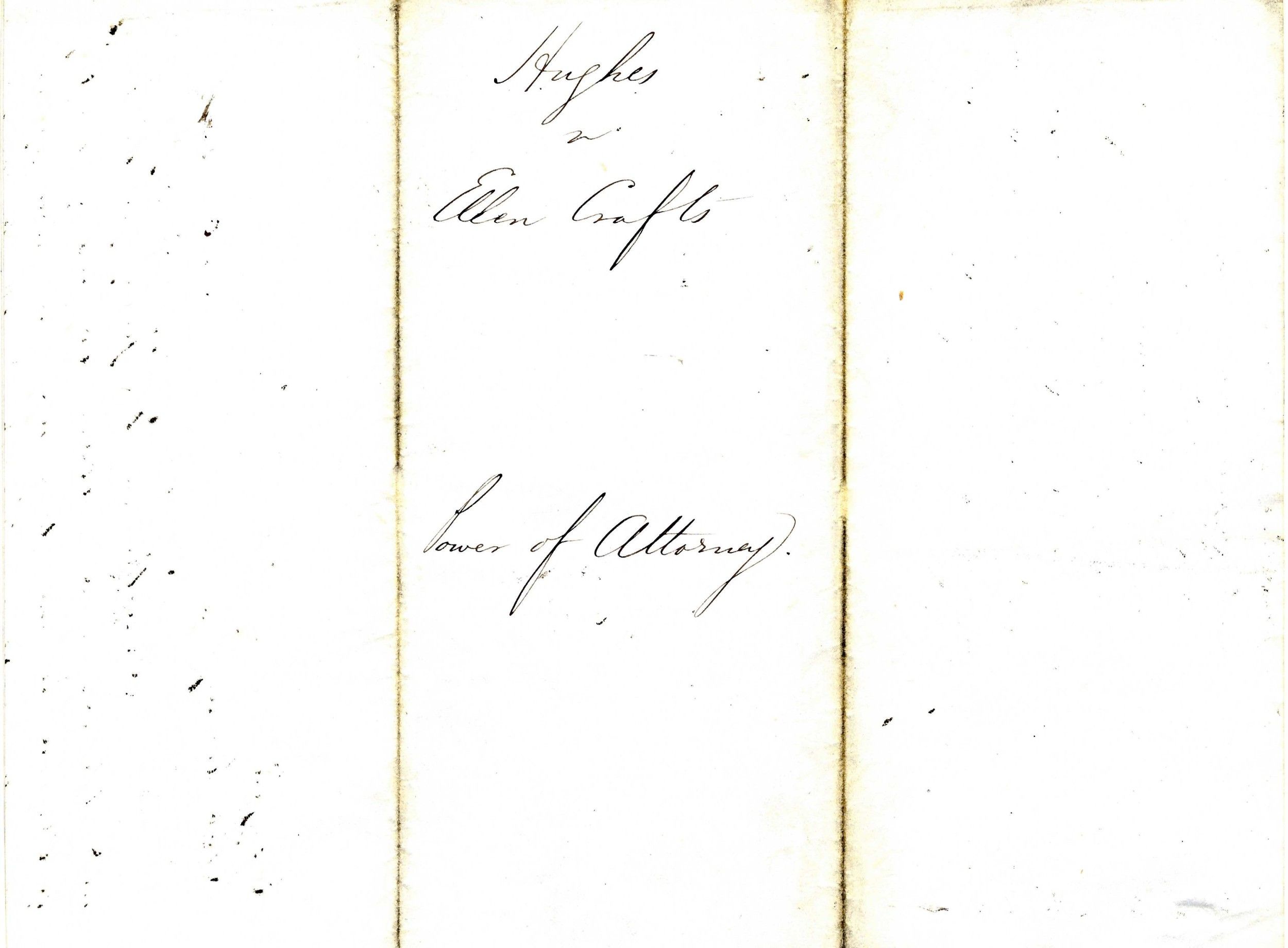
Robert Collins' Power of Attorney
Page 2
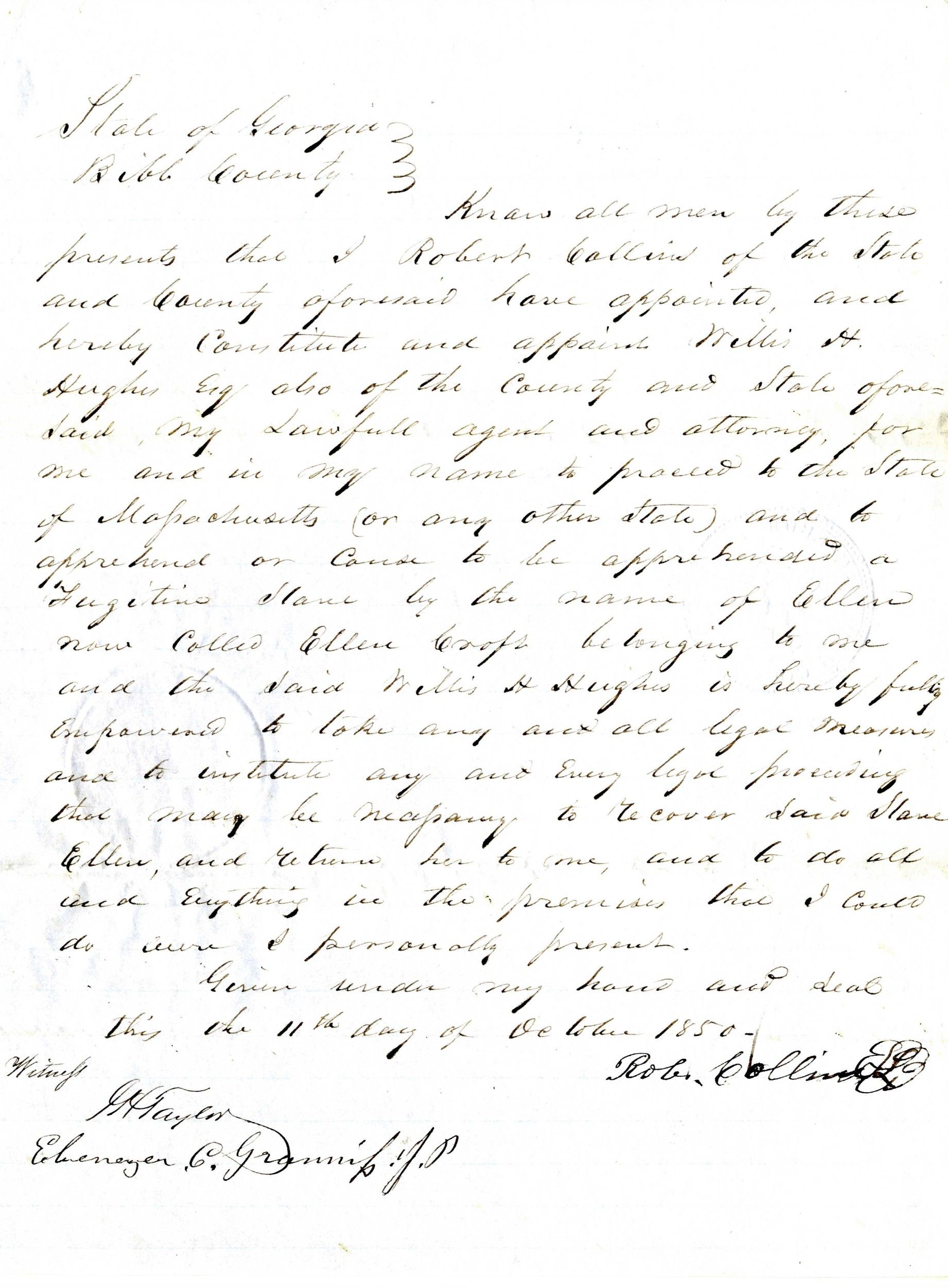
Robert Collins' Power of Attorney
Page 3
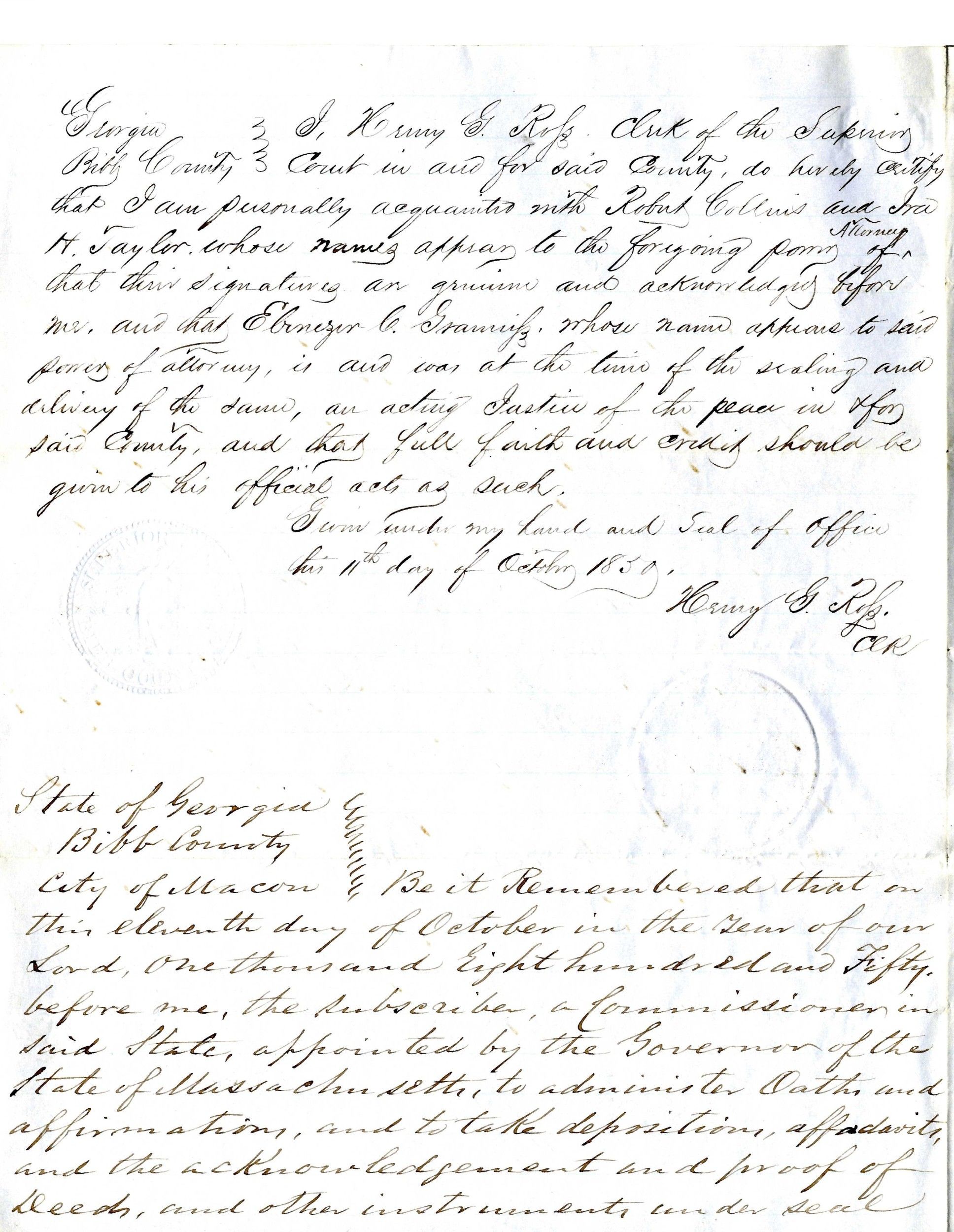
Robert Collins' Power of Attorney
Page 4
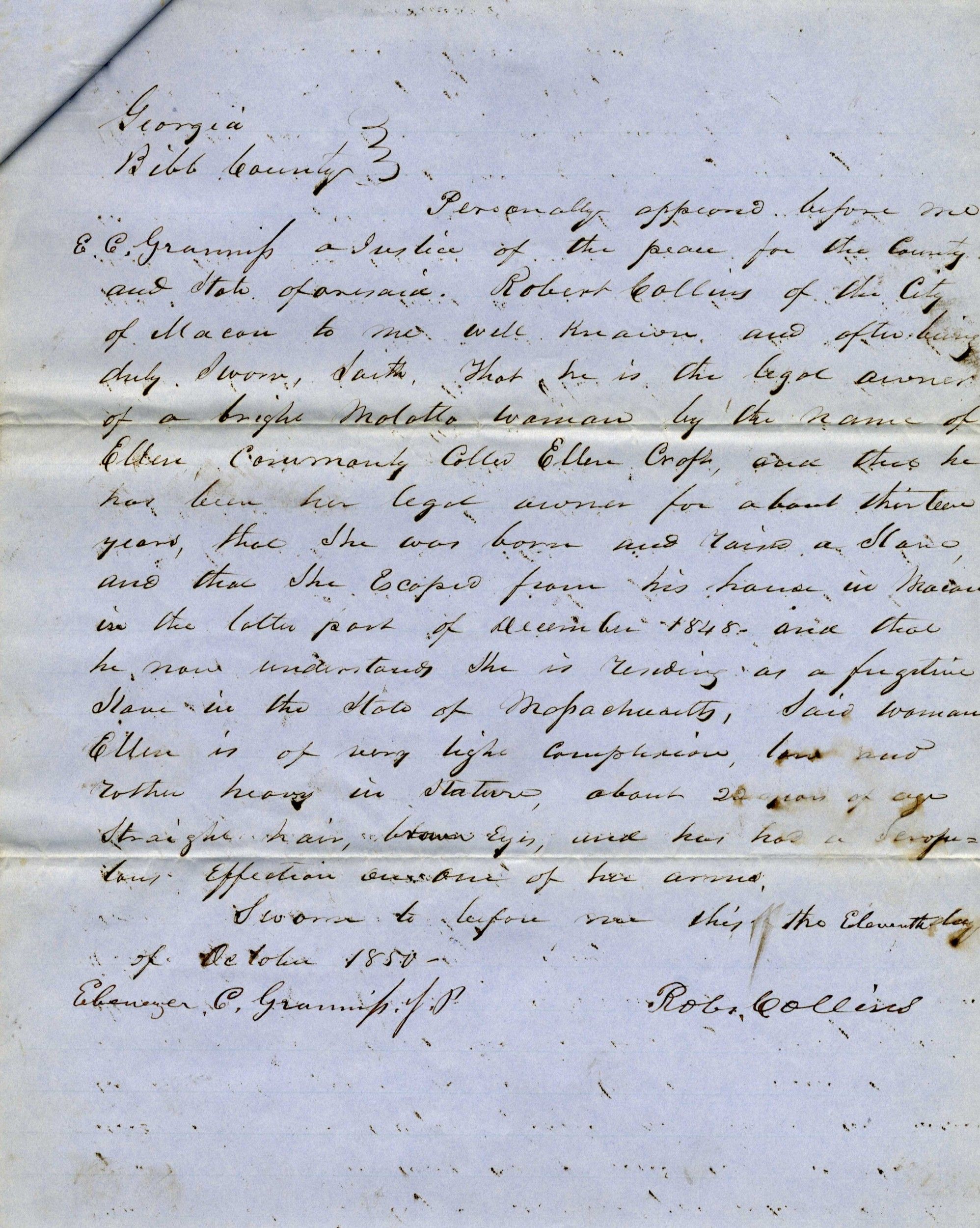
Robert Collins' Power of Attorney
Page 5
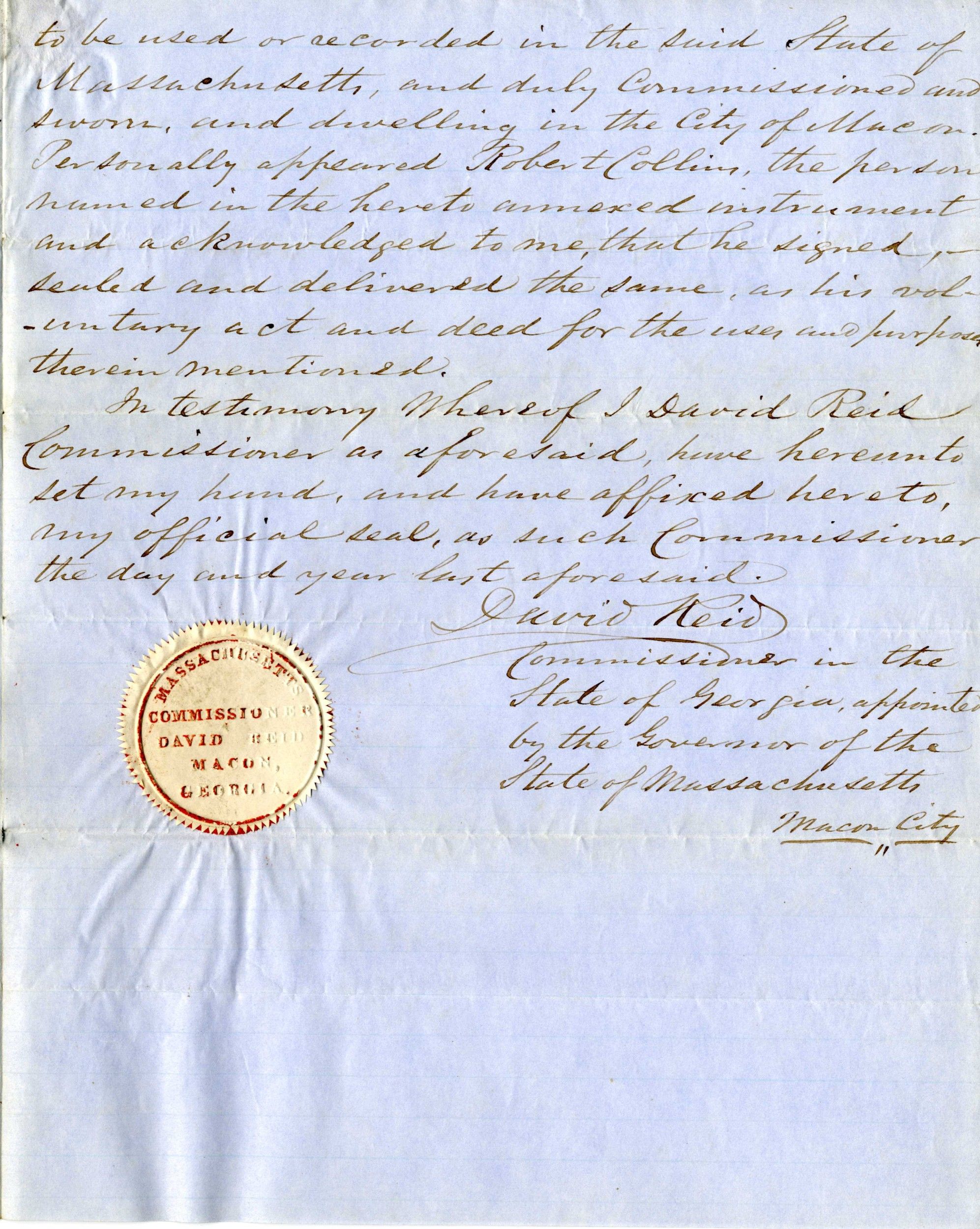
Document
U.S. Marshal's Return of Writ to Apprehend William Craft
12/9/1850
William (1824-1900) and Ellen Craft (1826-1891) were enslaved people who escaped from their respective masters in Macon, GA, in December 1848. Ellen, the daughter of an African-American woman and a white master, passed as a white gentleman accompanied by a slave valet, William.
They made their way to Boston, MA. The Census of 1850 shows them living in freedom at the home of Lewis Hayden. In 1850, a deputy U.S. Marshall sought them out at Hayden’s home, but Hayden denied that they were there and threatened violence, such that the U.S. Marshall departed.
The Crafts fled to Britain, where they lived for 20 years, raising their family, lecturing about the freedom movement, and writing their memoir Running a Thousand Miles for Freedom (1860) (available online from Documenting the American South (DocSouth). They later returned to the United States and settled in Georgia.
They made their way to Boston, MA. The Census of 1850 shows them living in freedom at the home of Lewis Hayden. In 1850, a deputy U.S. Marshall sought them out at Hayden’s home, but Hayden denied that they were there and threatened violence, such that the U.S. Marshall departed.
The Crafts fled to Britain, where they lived for 20 years, raising their family, lecturing about the freedom movement, and writing their memoir Running a Thousand Miles for Freedom (1860) (available online from Documenting the American South (DocSouth). They later returned to the United States and settled in Georgia.
This primary source comes from the Records of District Courts of the United States.
National Archives Identifier: 7175606
Full Citation: U.S. Marshal's Return of Writ to Apprehend William Craft; 12/9/1850; Willis H. Hughes v. William Craft; Case Files, 1790 - 1911; Records of District Courts of the United States, ; National Archives at Boston, Waltham, MAl. [Online Version, https://docsteach.org/documents/document/us-marshals-return-of-writ-to-apprehend-william-craft, April 18, 2024]U.S. Marshal's Return of Writ to Apprehend William Craft
Page 1
